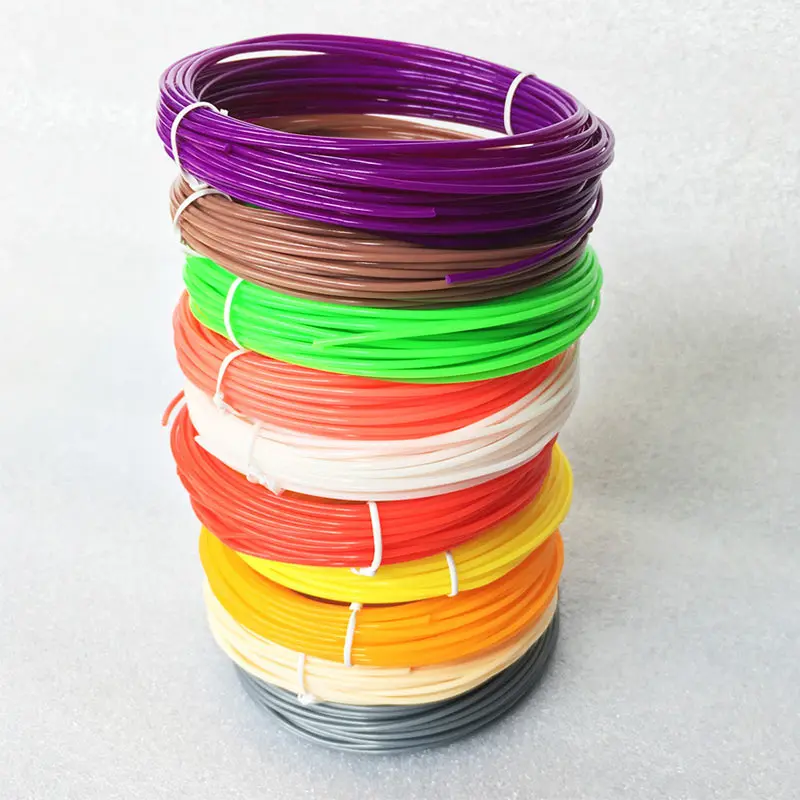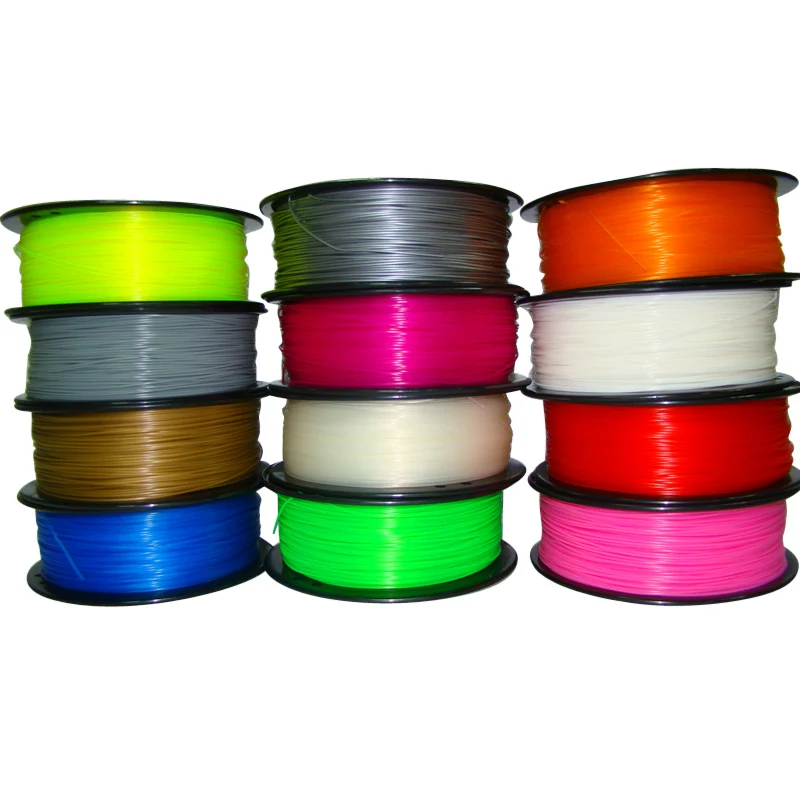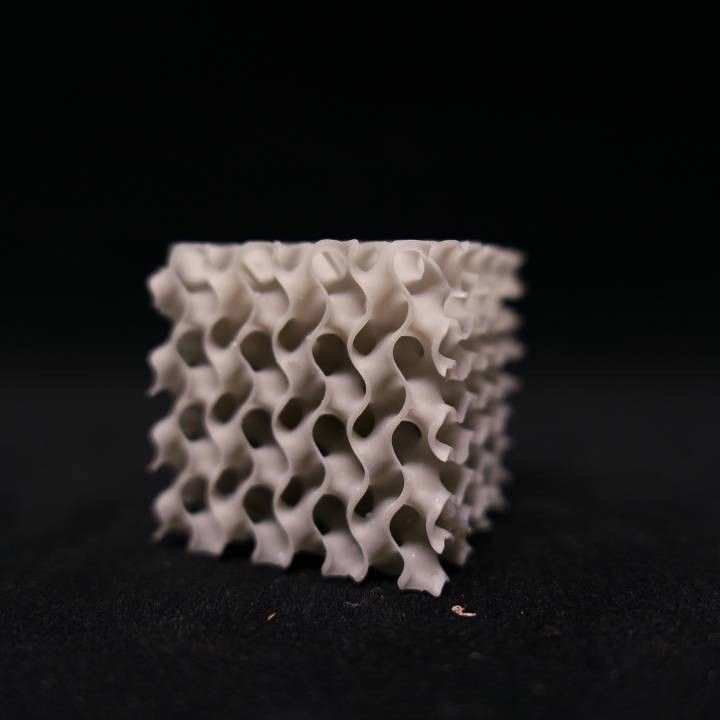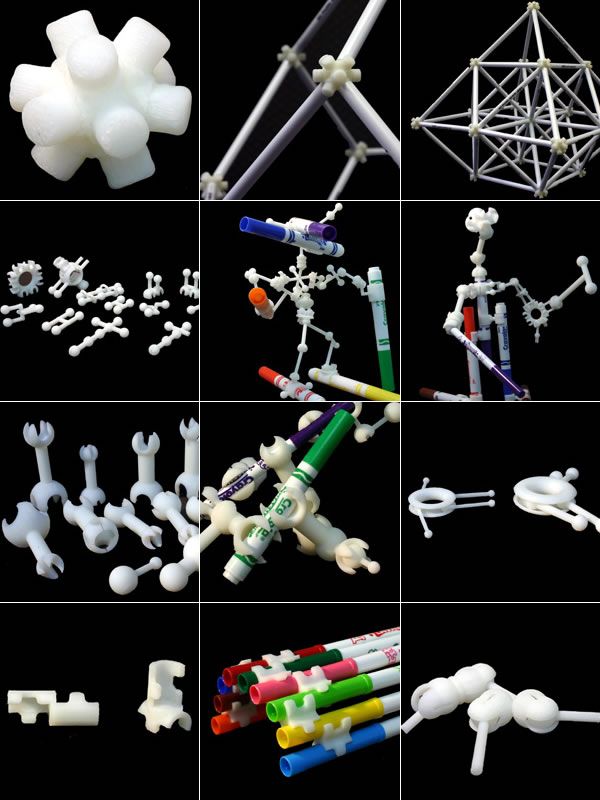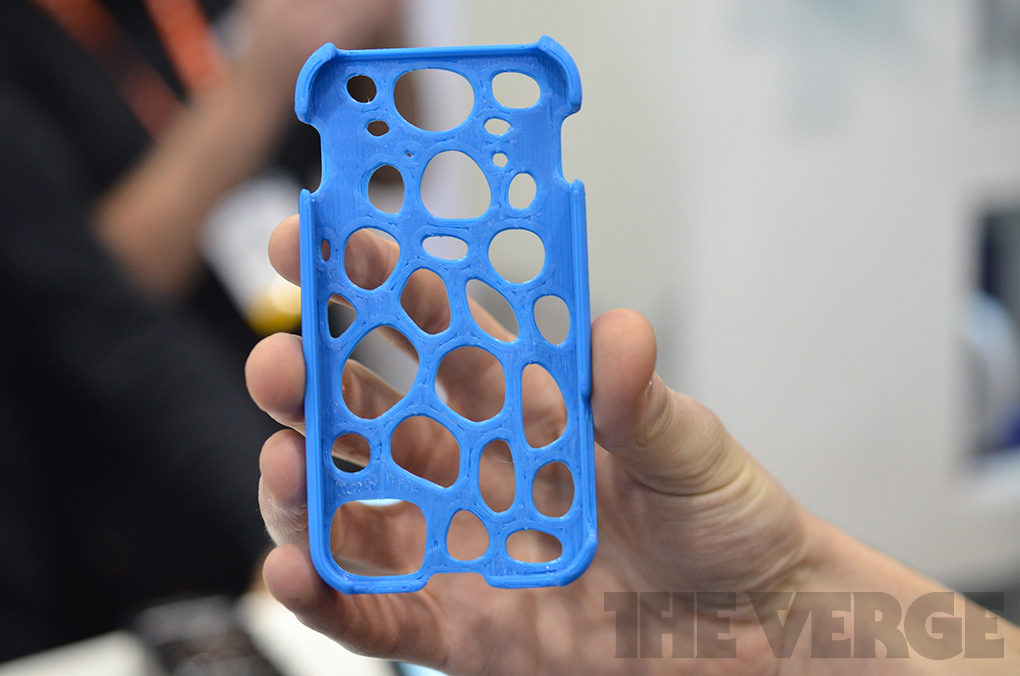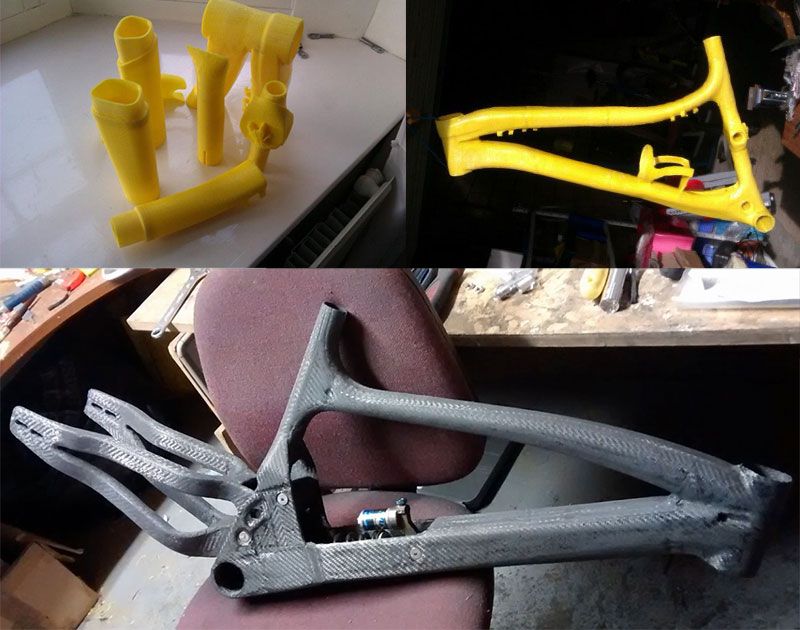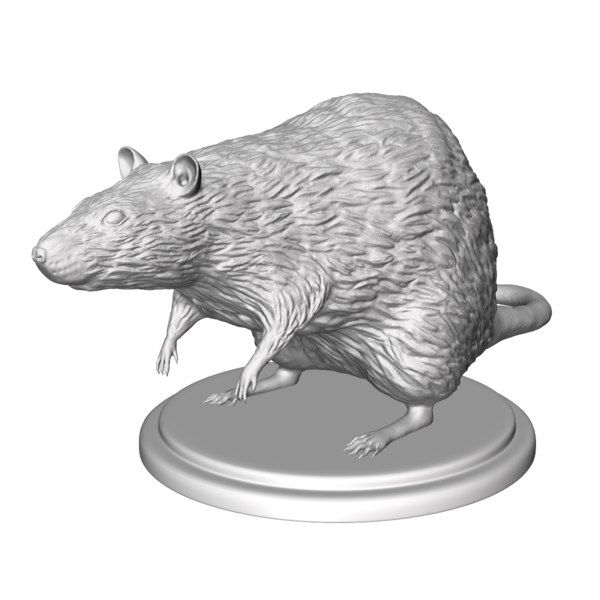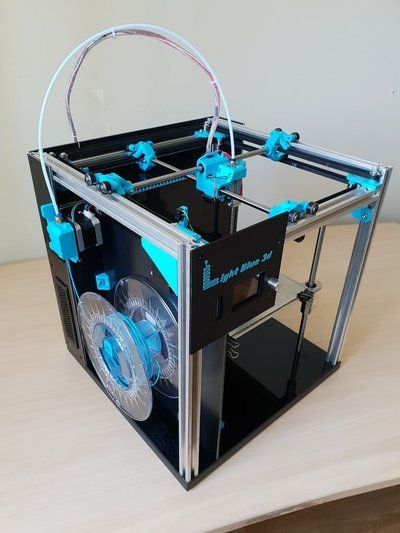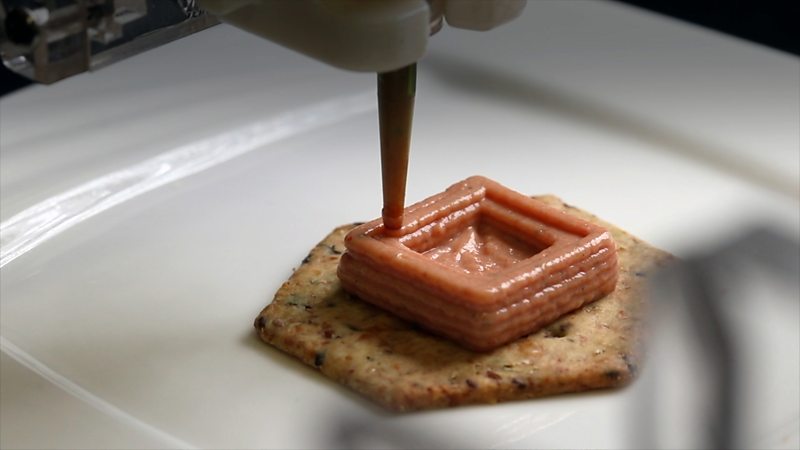Pla material for 3d printing
What is PLA plastic filament and how to use it for 3D printing ?
What is PLA plastic material ? Get all information and advice to help you print your 3D model with filament fabrication, using FDM 3D printing technology. Affordable and reliable, start 3D printing using PLA filament.
Colors
Characteristics
Surface Look
Details
Strength
Flexibility
PLA Filament Material Guide
Overview
Design Guide
Technical Specifications
What is PLA material?
PLA plastic or polylactic acid is a vegetable-based plastic material, which commonly uses cornstarch or sugarcane as a raw material. The monomer is usually made from fermented plant starch. This material is a thermoplastic aliphatic polyester and it is the primary natural raw material used in 3D printing. PLA is a fully biodegradable thermoplastic polymer consisting of renewable raw materials. Among all 3D printing materials, PLA is part of the most popular materials used for additive manufacturing for filament fabrication.
PLA is a bioplastic, used in 3D printing using the FDM (Fused Deposition Modeling) technology, and along with ABS (Acrylonitrile Butadiene Styrene), this material is one of the standard materials for this technology. There is often a tendency to compare these plastic materials, as they are the two most common alternatives available for consumer printers. PLA plastic material is easy-to-use and offer some interesting mechanical properties.
PLA material is printed using BigRep 3D printers and mainly used to manufacture big parts up to 1x1x1m.
Even if this PLA material offers the opportunity to 3D print impressive big parts, please keep in mind that you will have to respect specific design guidelines to avoid any problem during the additive manufacturing process. Be sure to check the material design guidelines while creating your 3D file and before you send it for 3D printing.
Be sure to check the material design guidelines while creating your 3D file and before you send it for 3D printing.
If you want to know more about the general properties of PLA filament, you can check our “Technical Specifications” part.
What is PLA plastic used for ?
PLA plastic filament quickly became a popular material due to it being economically produced from renewable resources. PLA plastic material comes in the form of wire on a spool, which is fed into the extruder head where the plastic is melted and deposited in a continuous extrusion on the printing tray. This material is translucent in its natural form, but spools of coloured filament can be used to make objects in different colors.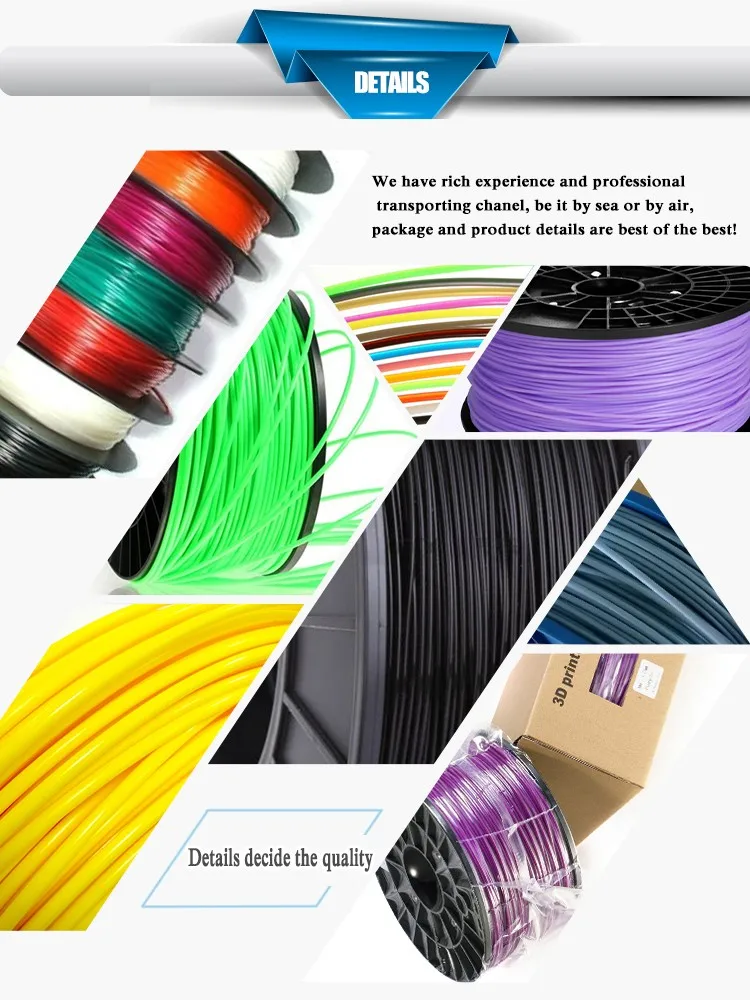
When cooling, this material shrinks less than ABS, which gives it good geometric stability during the manufacturing process.
PLA can be useful for your product development, as this material can be used for rapid prototyping.
Large-scale 3D printing is the main advantages of the PLA we are offering at Sculpteo, which can be a great benefit for a wide range of applications. This material offers you the possibility to print professional and industrial parts of 1m x 1m x 1m thanks to a large 3D printer! BigRep PLA material, has good strength and stiffness, making this 3D printing material filament is ideal for demanding industrial production. 3Dp BigRep PLA can perfectly be used to 3D print large objects for architecture or construction fields but also for marketing displays, exhibitions or signage.
This 3D printing filament is an affordable and versatile plastic. It can easily be used for prototypes, pattern making, tooling parts, or end-use parts. However, there are still some disadvantages such as photodegradation which is caused by UV radiation if PLA is exposed to sunlight.
However, there are still some disadvantages such as photodegradation which is caused by UV radiation if PLA is exposed to sunlight.
We inform you that this material is not suited for applications requiring suitability with high humidity (more than 98%) or high temperatures (above 60°C). Make sure you check the physical mechanical properties of the PLA plastic 3D printing material before.
Pricing for PLA 3D printing filament
To get your PLA parts 3D printed, please contact directly our sales team to place your order. It is not possible to order your parts on the website.
However, the price of the design is calculated on a series of factors, including its size, its volume, and the amount of material needed to manufacture your parts.
Our sales team will keep you updated regarding the price and the shipping time of your parts.
How does FDM 3D printing technology work?
BigRep PLA parts are 3D printed using a traditional FDM 3D printing process.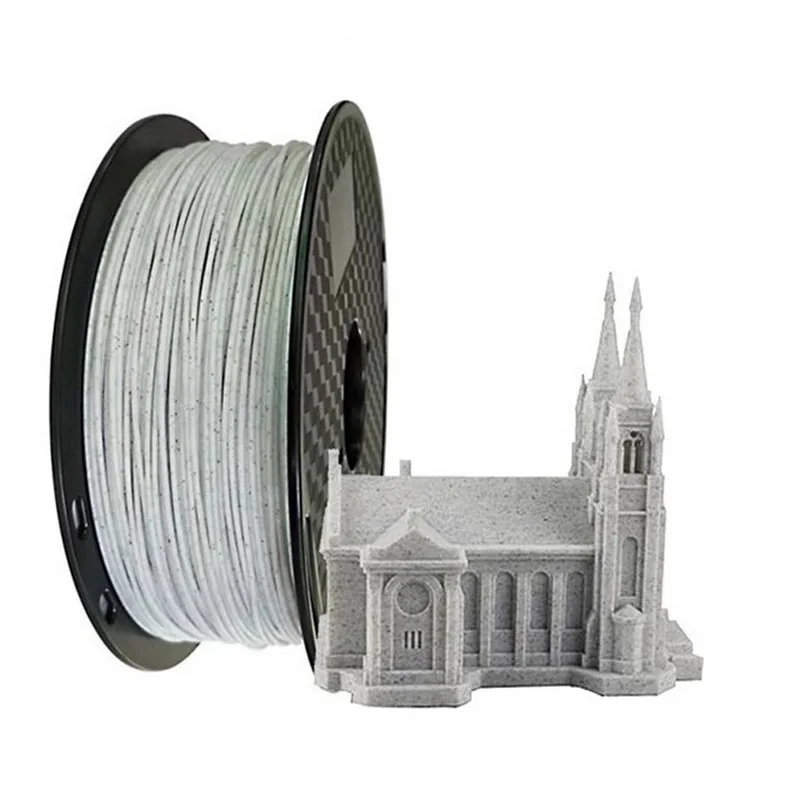 Even if BigRep printers are impressive and big machines, the FDM printing process stays the same. During the FDM 3D printing process, the filament is extruded through a nozzle which melts while being gradually deposited in a structured way on the build platform of the 3D printer until the object is finished.
Even if BigRep printers are impressive and big machines, the FDM printing process stays the same. During the FDM 3D printing process, the filament is extruded through a nozzle which melts while being gradually deposited in a structured way on the build platform of the 3D printer until the object is finished.
Colors and Finishings available for PLA plastic material
Your PLA plastic parts can take on a variety of colors with many color options available according to your project specifications. We are also offering Chemical Smoothing and painting options, please contact us to discuss your color and finishing options to your 3D printed PLA parts.
Maximum size
Maximum size | 1 x 1 x 1 m |
The maximum size of your models are limited by the physical size of our 3D printers – nothing can be printed larger than the printer bed. |
Mechanical Properties
Documentation
| Filament Sizes: | 2.3, 4.5, and 8.0 kg |
| Diameter: | 2.85 mm |
| Density: | 1.24 g/cm³ |
| Flexural Modulus (ISO 178): | 3800 MPa |
| Tensile Strength (ISO 527): | 60 MPa |
| Impact Strength Notched: | 7.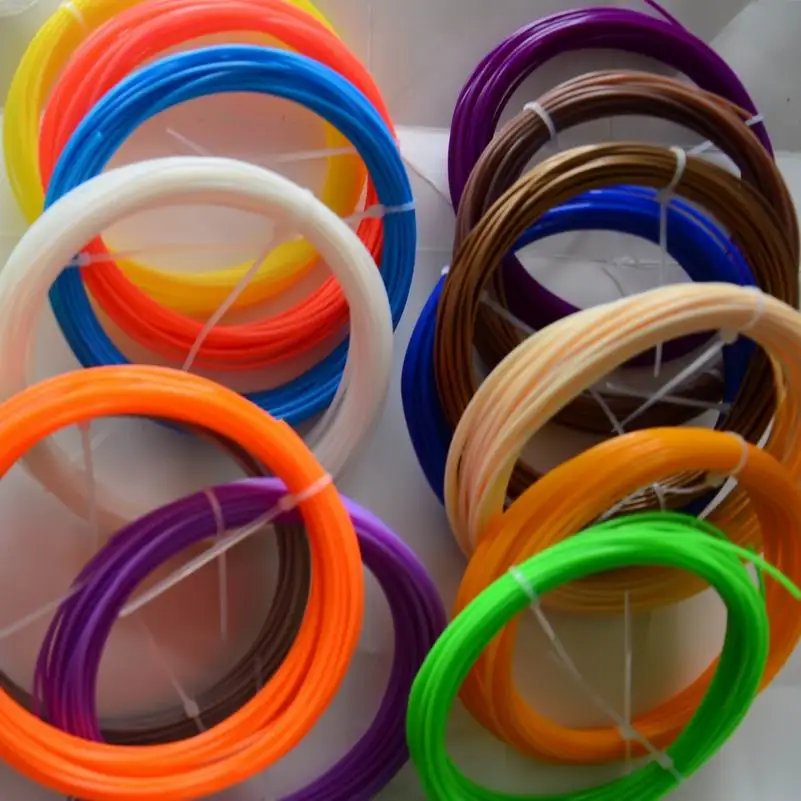 5 kJ/m² 5 kJ/m² |
| Heat Resistance HDT / B (ISO 75): | 40 °C |
| Hardness (Shore): | D 60 |
What does PLA material stand for?
PLA stands for Polylactic acid. It is a thermoplastic monomer derived from renewable, organic sources such as corn starch or sugar cane.
Is PLA plastic biodegradable?
PLA is biodegradable under certain composting conditions.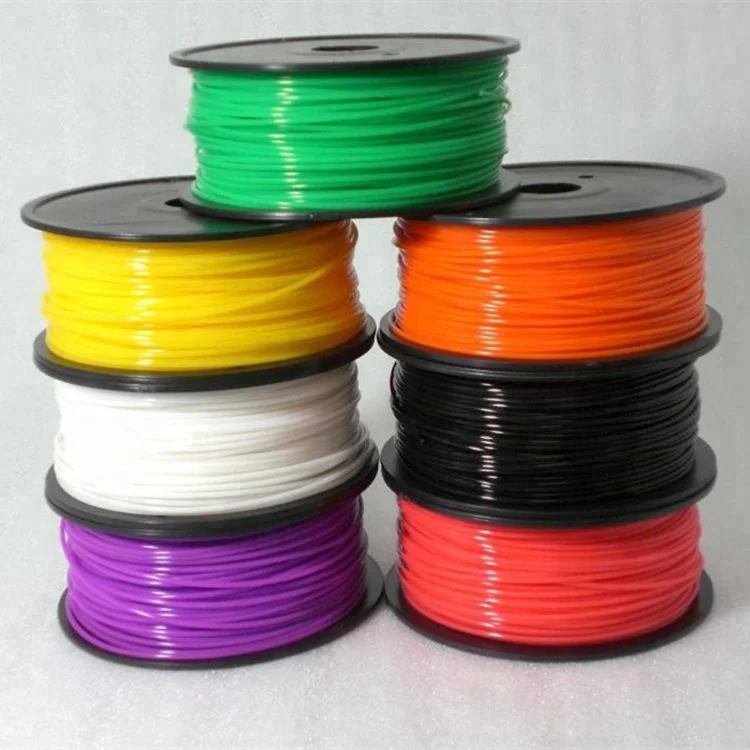 PLA is still a plastic material and requires a laundry list of conditions to effectively break down.
PLA is still a plastic material and requires a laundry list of conditions to effectively break down.
Is PLA actually plastic?
PLA is a plastic material. PLA is made from a biomass resource, it is a vegetable-based plastic material, which commonly uses cornstarch as a raw material.
Is ABS or PLA better for 3D printing?
PLA is a perfect material if you need to 3D print parts where aesthetics is important.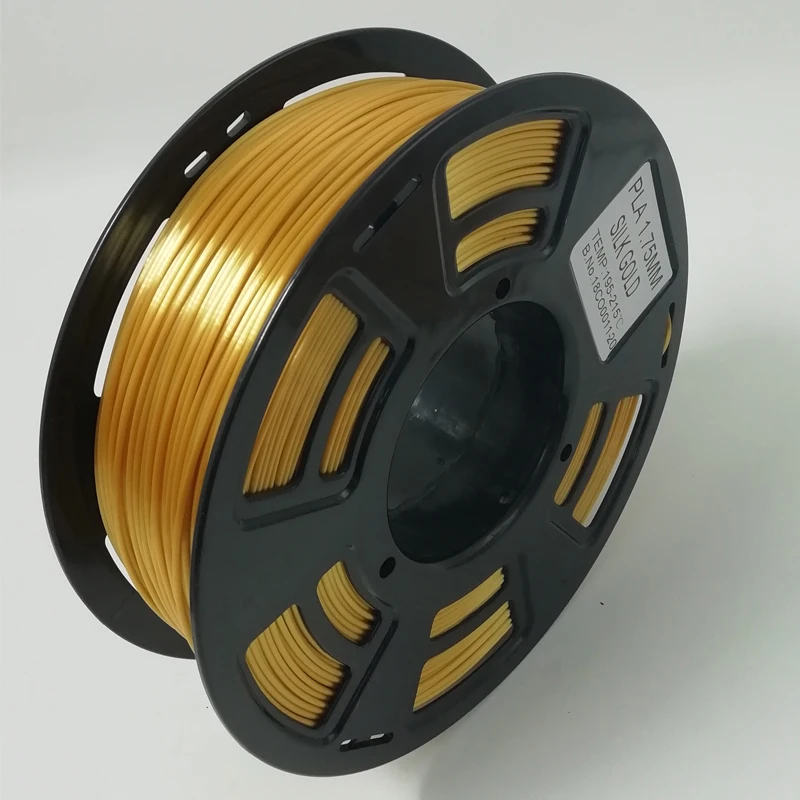 ABS is a good material for applications where strength, ductility, machinability and thermal stability are required.
ABS is a good material for applications where strength, ductility, machinability and thermal stability are required.
Related blog posts:
Ready to 3D print with PLA plastic material?
With Sculpteo’s online 3D printing service you’re just a few clicks away from professional PLA 3D printing. Your 3D model is printed with the highest quality and delivered straight to your door.
Get started now to get your PLA prints!
Discover our other plastic materials...
Ultimate Materials Guide - Tips for 3D Printing with PLA
Overview
Polylactic Acid, commonly known as PLA, is one of the most popular materials used in desktop 3D printing. It is the default filament of choice for most extrusion-based 3D printers because it can be printed at a low temperature and does not require a heated bed. PLA is a great first material to use as you are learning about 3D printing because it is easy to print, very inexpensive, and creates parts that can be used for a wide variety of applications.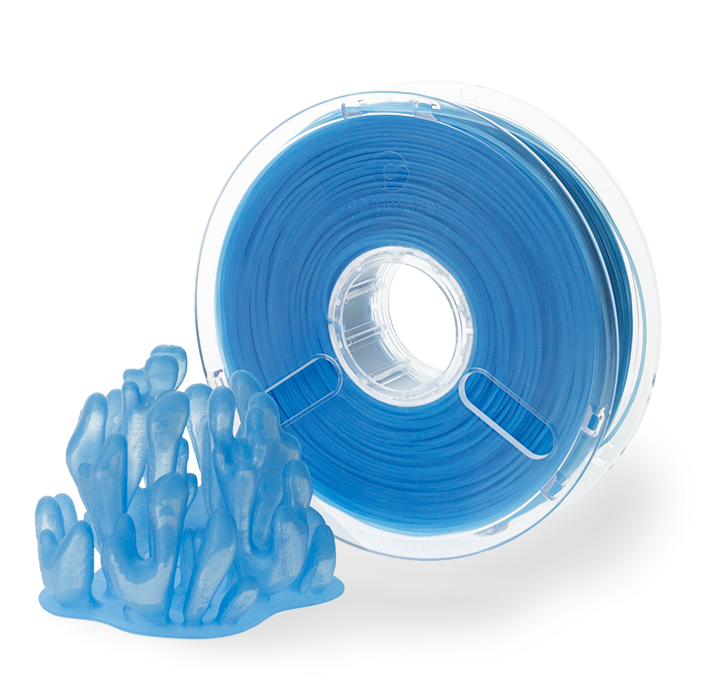 It is also one of the most environmentally friendly filaments on the market today. Derived from crops such as corn and sugarcane, PLA is renewable and most importantly biodegradable. As a bonus, this also allows the plastic to give off a sweet aroma during printing.
It is also one of the most environmentally friendly filaments on the market today. Derived from crops such as corn and sugarcane, PLA is renewable and most importantly biodegradable. As a bonus, this also allows the plastic to give off a sweet aroma during printing.
- Low Cost
- Stiff and good strength
- Good dimensional accuracy
- Good shelf life
- Low heat resistance
- Can ooze and may need cooling fans
- Filament can get brittle and break
- Not suitable for outdoors (sunlight exposure)
Hardware Requirements
Before 3D printing with PLA make sure your 3D Printer meets the hardware requirements listed below to ensure the best print quality.
Bed
Temperature: 45-60 °C
Heated Bed Optional
Enclosure not required
Build Surface
Painter’s tape
PEI
Glass plate
Glue stick
Extruder
Temperature: 190-220 °C
No special hot-end required
Cooling
Part Cooling Fan Required
Fan Speed: 100%
Best Practices
These tips will help you reduce the chances of common 3D printing issues associated with PLA such as stringing, oozing, or under-extrusion.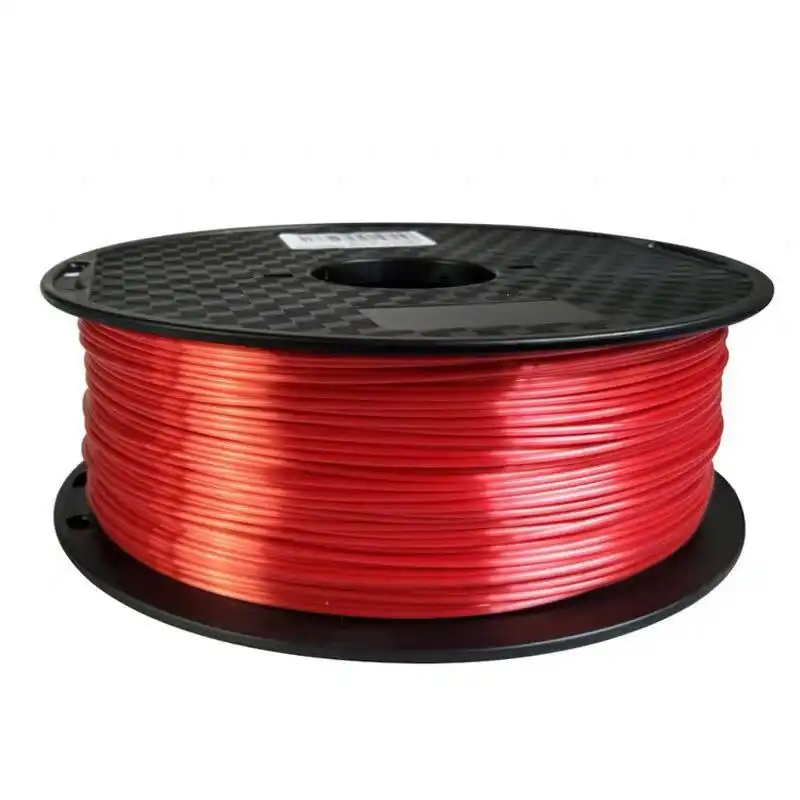
Fine Tune the Retractions to Prevent Oozing
One of the most common problems with PLA is oozing. Since the filament flows relatively easily when compared to the other materials, it has a tendency to continue flowing during travel movements at the end of a segment. This creates strings or hairs on your part, and dialing in your retraction settings is the best way to combat this behavior! Different brands of PLA and different printers may need slightly different retraction settings, so you may need to experiment to find the best value for your printer. Simplify3D added a very useful feature in Version 4.0 that can help with this, by allowing you to quickly try dozens of different settings, and then look at the final part to determine which one worked the best on your specific setup. For example, you could setup two vertical pillars which are printed side-by-side to evaluate stringing when moving back-and-forth between each pillar. Then go to Tools > Variable Settings Wizard and choose how you want to adjust your settings during the print.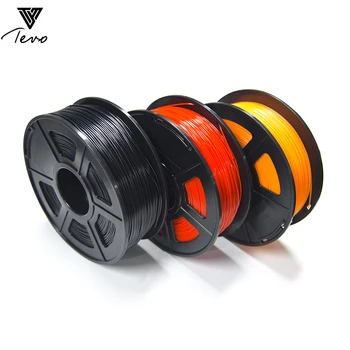 For example, you could try a different retraction distance for each 20mm section of the print and then pick the value that works best in the end. For more tips on how to reduce stringing and oozing, be sure to check out our Print Quality Guide which contains an entire section dedicated to this issue: How to Reduce Stringing and Oozing.
For example, you could try a different retraction distance for each 20mm section of the print and then pick the value that works best in the end. For more tips on how to reduce stringing and oozing, be sure to check out our Print Quality Guide which contains an entire section dedicated to this issue: How to Reduce Stringing and Oozing.
Optimize Your Cooling Settings
Cooling is one of the most important aspects of printing with PLA. Having a dedicated part cooling fan makes a huge difference in the quality of the printed parts. The freshly extruded plastic needs to cool down below the glass transition temperature as quickly as possible. This will prevent the plastic from stringing and producing other artifacts. We recommend setting the fan to 100% throughout the print, except for the first 1-2 layers where you want to form a strong bond with the print bed. Simplify3D also includes a useful option on the Cooling tab of your process settings that can automatically reduce the print speed for small parts, ensuring that the layers have sufficient time to cool.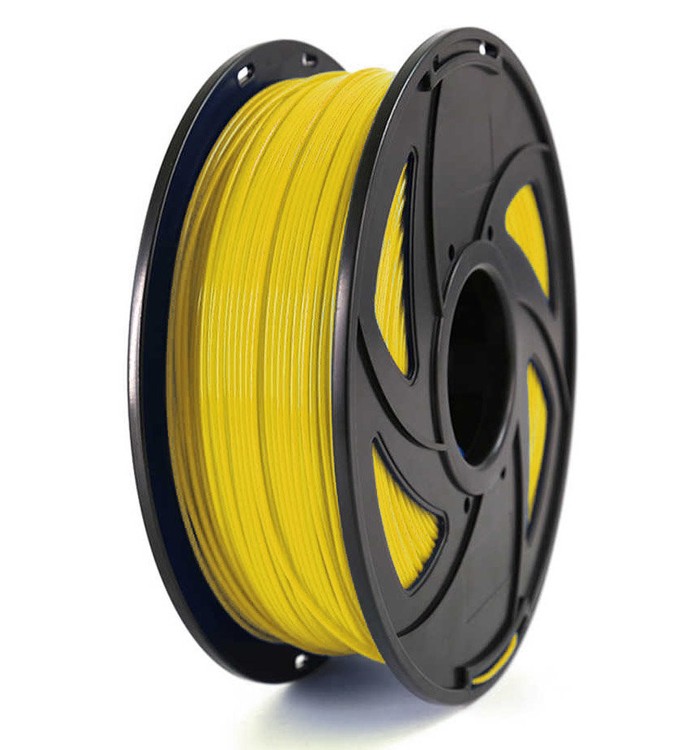 This can greatly improve the print quality by allowing the layer to solidify before printing the next layer on top of it. This setting can be found on the Speeds tab of your process settings.
This can greatly improve the print quality by allowing the layer to solidify before printing the next layer on top of it. This setting can be found on the Speeds tab of your process settings.
Choose the Correct Extruder Temperature
This is a great tip for any filament, but is especially useful for PLA which often contains different combinations of additives depending on the manufacturer. These different additives can lead to variations in printing temperature between 190-230 degrees Celsius. If you are not printing at the right temperature this can lead to several print quality issues including oozing, stringing, and under-extrusion. PLA can also be combined with different fills like metal, wood, and fiber that give it different characteristics than a standard homogeneous PLA. These may require different settings or even different hardware. Be sure to check with the manufacturer of your filament to verify the optimal temperature to use for your specific filament. If you have trouble with stringing, try reducing this temperature by 5-10 degrees, which will help prevent the excess oozing.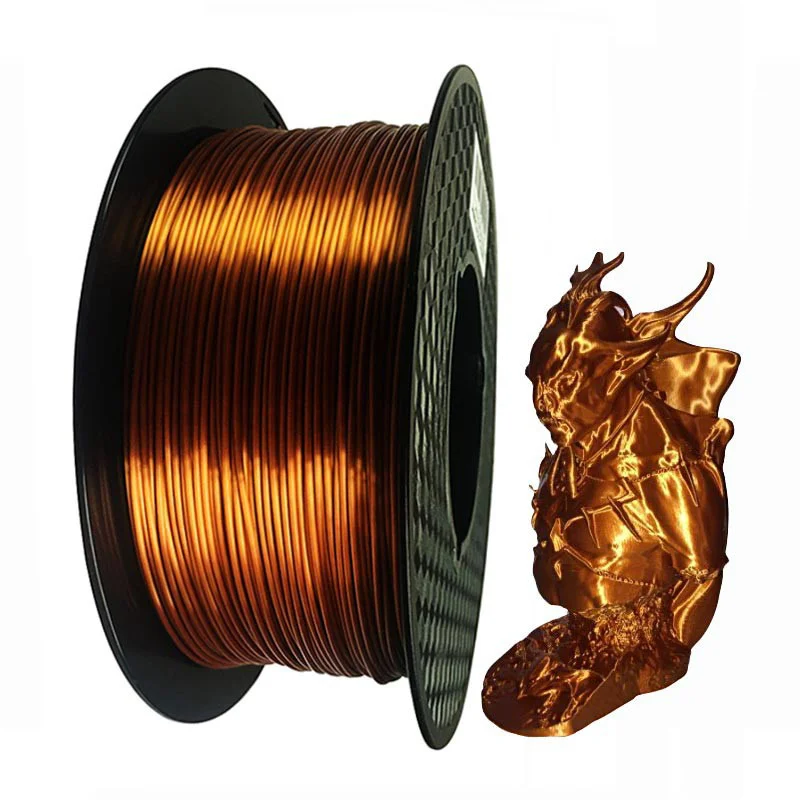 If you’re struggling with under-extrusion, try increasing the temperature by 10 degrees so that the material flows more easily through the nozzle.
If you’re struggling with under-extrusion, try increasing the temperature by 10 degrees so that the material flows more easily through the nozzle.
Pro-Tips
- Using a fan that cools the 3D printed part from all directions is highly recommended. Many popular 3D printers have community-designed attachments that can be printed and retrofitted onto your machine to improve the cooling airflow.
- Increasing the number of perimeter outlines for your PLA prints will create a strong bond between each layer, creating stronger parts that are less prone to breaking.
Get Started with PLA
Now that you are ready to start printing with PLA, here’s a bit more information to help you get started. Start thinking of project ideas by reviewing our common applications, try out one of the provided sample projects, or find a new filament to try from our list of popular material brands.
Common Applications
- Test and calibration items
- Dimensionally accurate assemblies
- Decorative Parts
- Cosplay Props
Sample Projects
- LA Spring Motor, Rolling Chassis
- G – Clamp
- Storm Trooper Helmet
Popular Brands
- Polymaker PLA, PolyMax, PolyPlus
- ColorFabb PLA/PHA
- Hatchbox PLA
- eSun PLA
- Filamentum PLA
PLA plastic for 3D printing
- 1 Plastic composition
- 2 PLA safety
- 3 PLA Specifications
- 4 Advantages of PLA in 3D printing
- 5 Navigation
PLA-plastic (polylactide, PLA) - is a biodegradable, biocompatible, thermoplastic aliphatic polyester, the structural unit of which is lactic acid.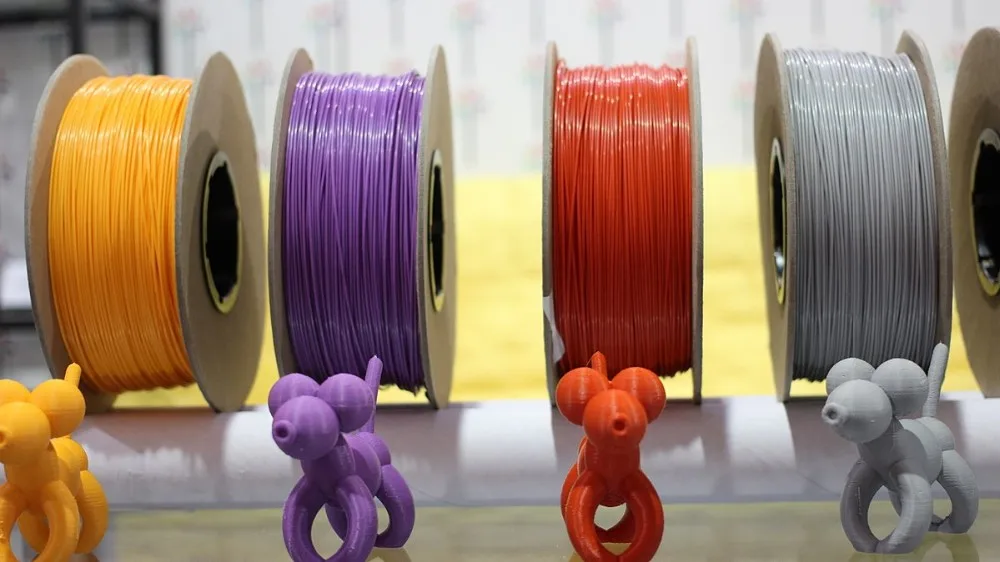
PLA is made from corn or sugar cane.
Potato and corn starch, soy protein, cassava tubers, cellulose are also used as raw materials.
Today, polylactide is actively used as a consumable for printing on 3D printers.
Natural raw materials in the composition of PLA-plastic allows using it for various purposes without a threat to human health.
The production of PLA plastic significantly reduces carbon dioxide emissions into the atmosphere compared to the production of "petroleum" polymers. The use of fossil resources is reduced by a third, the use of solvents is not required at all.
PLA is usually supplied as a thin filament that is wound on a spool.
| Melting point | 173-178°C |
| Softening point | 50°C |
| Hardness (Rockwell) | R70-R90 |
| Elongation at break | 3.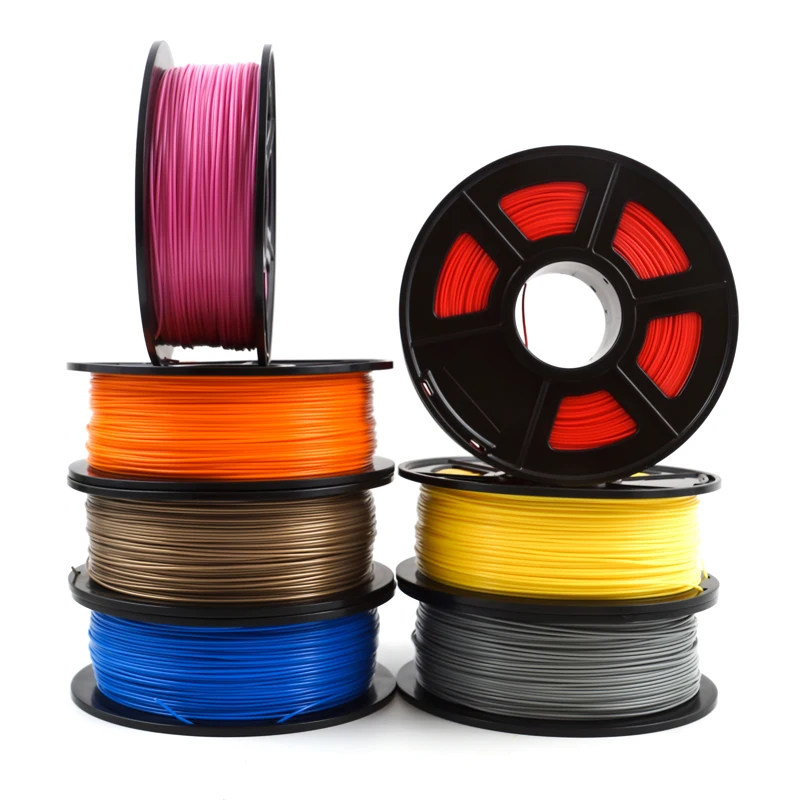 8% 8% |
| Flexural strength | 55.3 MPa |
| Tensile strength | 57.8 MPa |
| Tensile modulus | 3.3 GPa |
| Flexural modulus | 2.3 GPa |
| Glass transition temperature | 60-65°C |
| Density | 1.23-1.25 g/cm³ |
| Minimum wall thickness | 1 mm |
| Print Precision | ± 0.1% |
| Micron size | 0.3 mm |
| Manufacturing shrinkage | no |
| Moisture absorption | 0.5-50% |
- non-toxic;
- wide color palette;
- when printing, no need for a heated platform;
- dimensions are stable;
- is ideal for moving parts and mechanical models;
- excellent sliding of details;
- savings in energy costs due to the low softening temperature of the yarn;
- no need to use Kapton to lubricate the surface for building up the prototype;
- smoothness of the surface of the printed product;
- obtaining more detailed and completely ready-to-use objects.
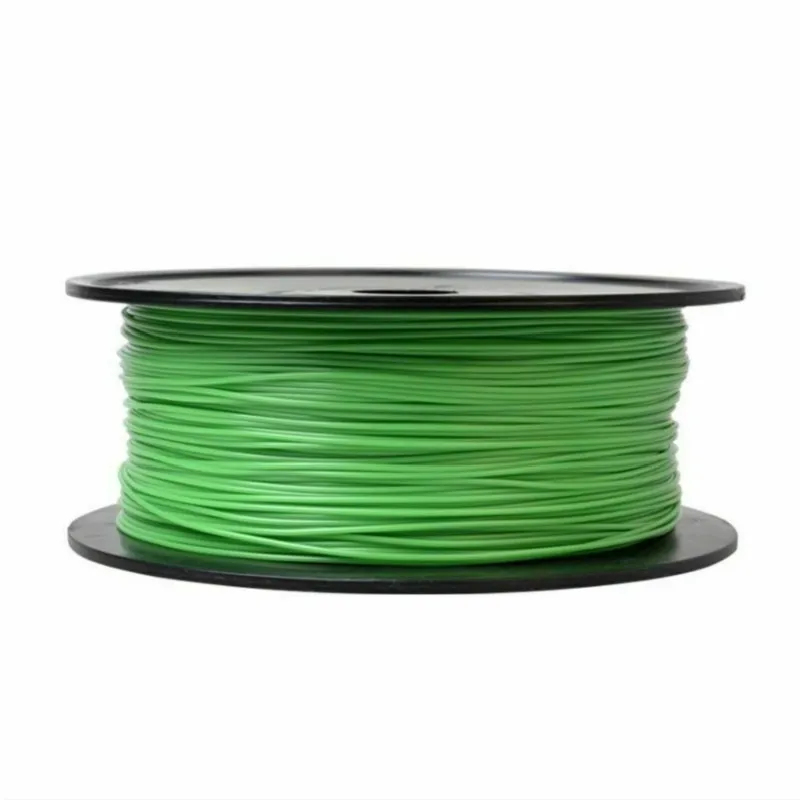
PLA plastic is ideal for 3D printing objects with great detail
Work with PLA plastic on a 3D printer is carried out using FDM-Fused Deposition Modeling technology. The thread is melted, after which it is delivered through a special nozzle to the surface for work and is deposited. As a result of building a model with molten plastic, an object completely ready for use is created. Products made of PLA plastic are subjected to grinding and drilling, painted with acrylic. However, it is worth remembering that the item made of PLA must be handled with care due to its fragility. Another disadvantage of PLA plastic is its fragility: the material lasts from several months to several years.
PLA is an ideal material for 3D printing prototypes and products that are not expected to be used for a long time. These can be decorative objects, presentation items, and items that require meticulous detailing.
Go to the main page of Encyclopedia of 3D printing
3D printing materials - plastic, photopolymer, gypsum, polyamide
ABS Plastic - + one
One of the most popular thermoplastics for FDM 3D printing is ABS plastic.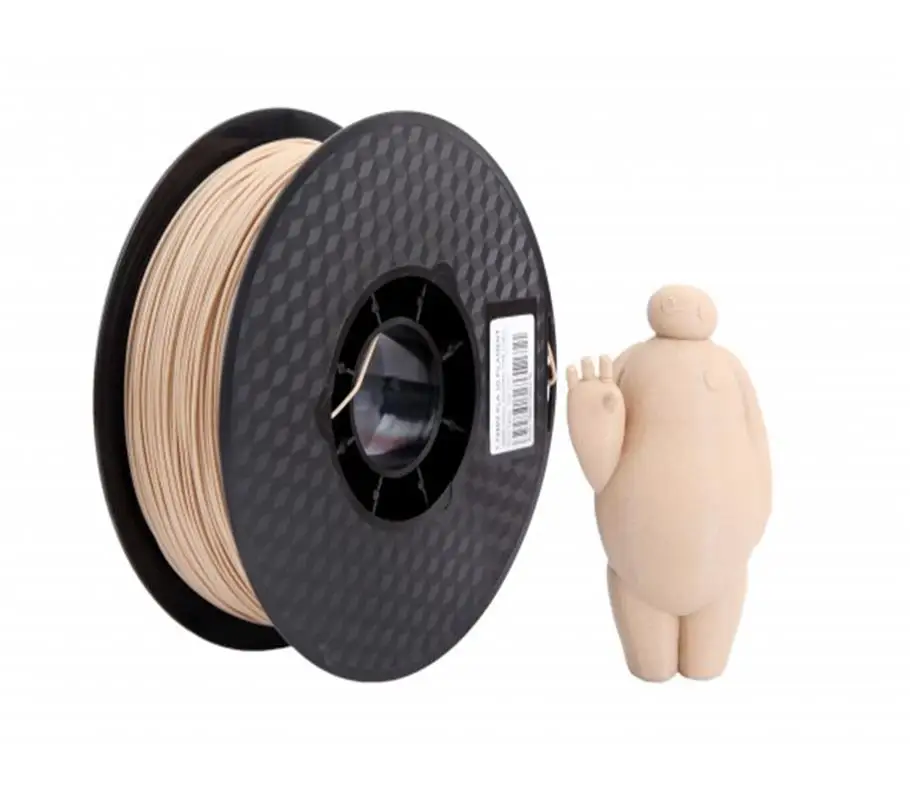 It is a synthetic polymer acrylonitrile butadiene styrene, which is widely used in industrial production for the manufacture of a wide variety of things.
It is a synthetic polymer acrylonitrile butadiene styrene, which is widely used in industrial production for the manufacture of a wide variety of things.
What can be printed with ABS?
ABS plastic is characterized by excellent surface machinability, impact resistance, and sufficient heat resistance. It can be used to print functional products and models for painting and refining. After printing, due to the peculiarities of the FDM technology, a pronounced layering is obtained, which is eliminated in an acetone bath. As a result of this treatment, you can get a perfect glossy surface. In general, the range of application of this thermoplastic is very, very wide. They can print:
• car parts;
• souvenirs;
• toys;
• functional models characterized by maximum tensile strength;
• cases of various devices and mechanisms;
• bijouterie;
• demonstration materials;
• sports equipment;
• plumbing parts;
• household items;
• parts for medical equipment and much more.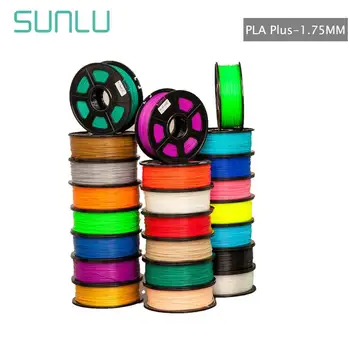
The range of use of ABS plastic is determined by its qualities, advantages and disadvantages.
ABS characteristics
ABS plastic has a lot of advantages. It is non-toxic, impact resistant, color fast and won't fade for years. This plastic is perfectly polished and painted, differs in moisture, oil and acid resistance. In addition, the low cost of the material attracts.
The specifications of ABS are as follows:
Operating temperature -40°C to +80°C
Tensile strength along layers 19.7 MPa
Charpy impact strength 180.14 kJ/m2
Modulus of elasticity in longitudinal tensile layers 2.34 GPa
Density 1.05 g/cm3
Flexural modulus 2.14 GPa
Tensile strength 29.6 MPa
Flexural strength 65.4 MPa
Maximum bending load 103 N
Tensile modulus 1.27 GPa
Maximum tensile load 785 N
Compressive strength 49.3 MPa
Maximum compressive load 5994 N
Compressive modulus 1.71 GPa
Tensile yield strength at 23°C 52 MPa
Softening point ~ 103°
Bending strength 2.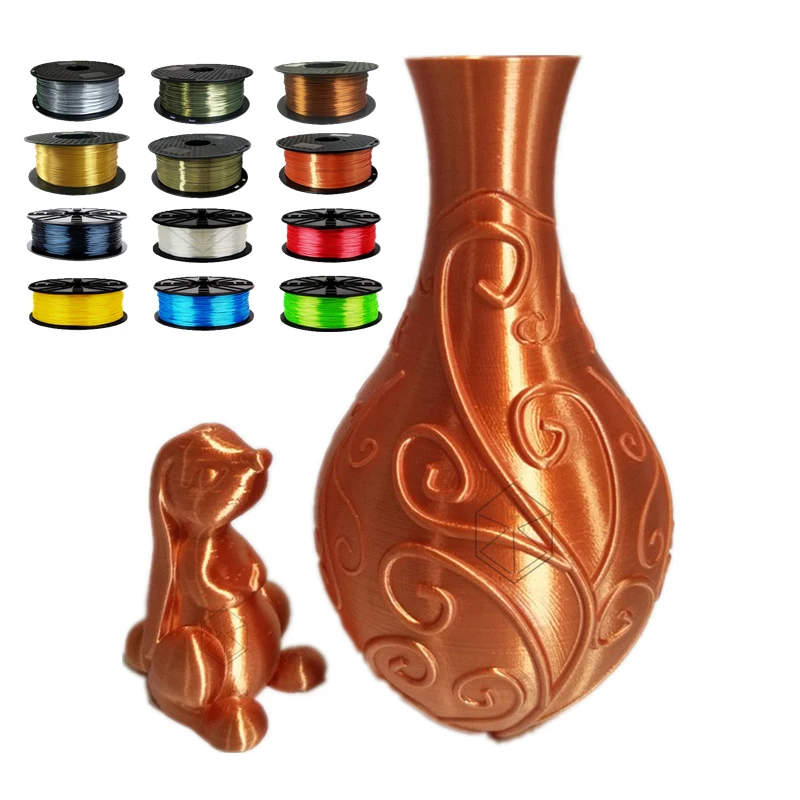 8 mm/min. 23°C 70 MPa
8 mm/min. 23°C 70 MPa
Rockwell hardness (R scale) impact 112
Izod viscosity 25 kJ/m2
Oil/gasoline resistance (max change in shape in 24 hours) 0.2%
Oxygen index, %O2 according to GOST 21793-76 18.2- 18.5
Mass fraction of ash according to GOST 15973 Less than 0.01%
PLA Plastic - + 2
The biodegradable, biocompatible, eco-friendly plastic for FDM 3D printing is PLA plastic. It is a thermoplastic aliphatic polyester, with a structural unit in the form of lactic acid. It is obtained from corn, sugar cane and other starchy natural materials. Therefore, when printed, this material emits a slight aroma of popcorn, which makes it the best choice for consumer and home 3D printing.
What can be printed with PLA?
PLA plastic is in many ways similar to ABS plastic, therefore it is applicable in areas similar in many respects to the previous plastic. This material is the second most popular and in demand.
PLA plastic is popular in schools and designers. Surgical threads, disposable tableware, biodegradable packaging, medical pins, personal care products, containers are printed from it. Since PLA has a low glass transition temperature and a low coefficient of friction, plain bearings can be produced from it. But it lends itself to rapid decomposition, costs more than ABS plastic, and cannot be sanded and smoothed with acetone.
This plastic begins to lose shape at 60 degrees Celsius, which should be taken into account when choosing this media. If the part will be operated at elevated temperatures, it is better to give preference to ABS. Also, this plastic is not suitable for printing those products that require elasticity and flexibility, such as phone cases and housings, tool holders. For such parts, it is better to choose a different material.
PLA Specifications
PLA plastic is very hard and does not shrink. Details from it are smooth, but at the same time more fragile and short-lived.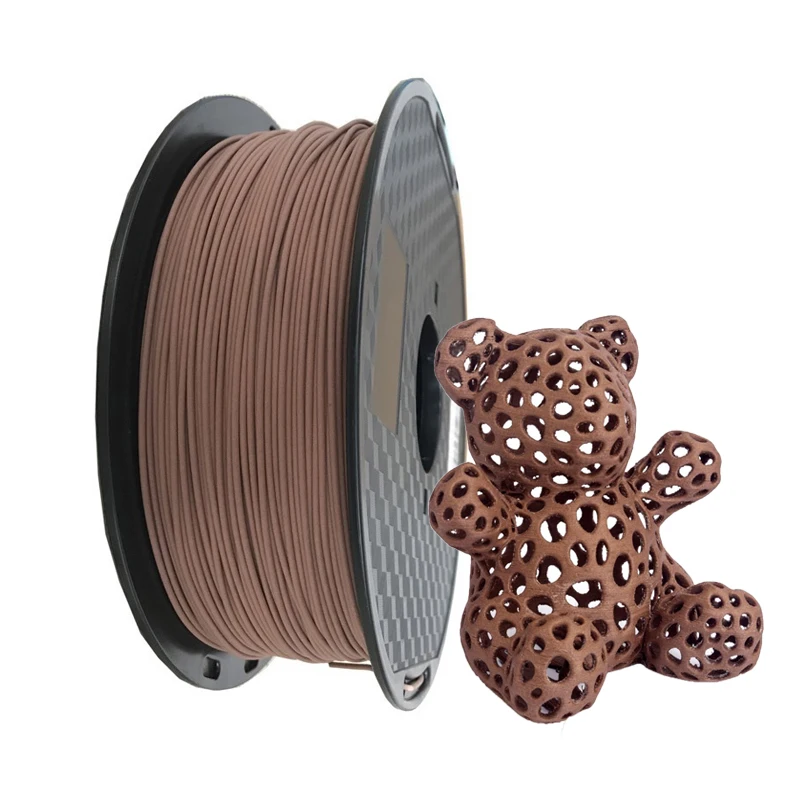 It is produced in a wide range of colors.
It is produced in a wide range of colors.
In addition, the material has the following technical characteristics:
Melting point 170-180°C
Thermal deformation temperature +50°C
Flexural strength 55.3 MPa
Tensile strength 57.8 MPa
Minimum wall thickness 1mm parts 0.3mm
Accuracy Up to 1%
Density 1.25 g/cm3
Water absorption 0.5-50%
Elongation at break 4.43%
SBS Plastic - + 3
Thermoplastic SBS is a more flexible and less rigid material for 3D printing compared to ASB, related to styrene-butadiene-styrene rubbers. This plastic thread is characterized by a more flexible structure. It does not burn and break like PLA. Possesses high moisture resistance that allows to use products from it in the damp environment.
What is printed with SBS?
SBS plastic is used for 3D printing of mechanical and engineering parts, as it has the characteristics of flexibility, heat resistance and impact resistance.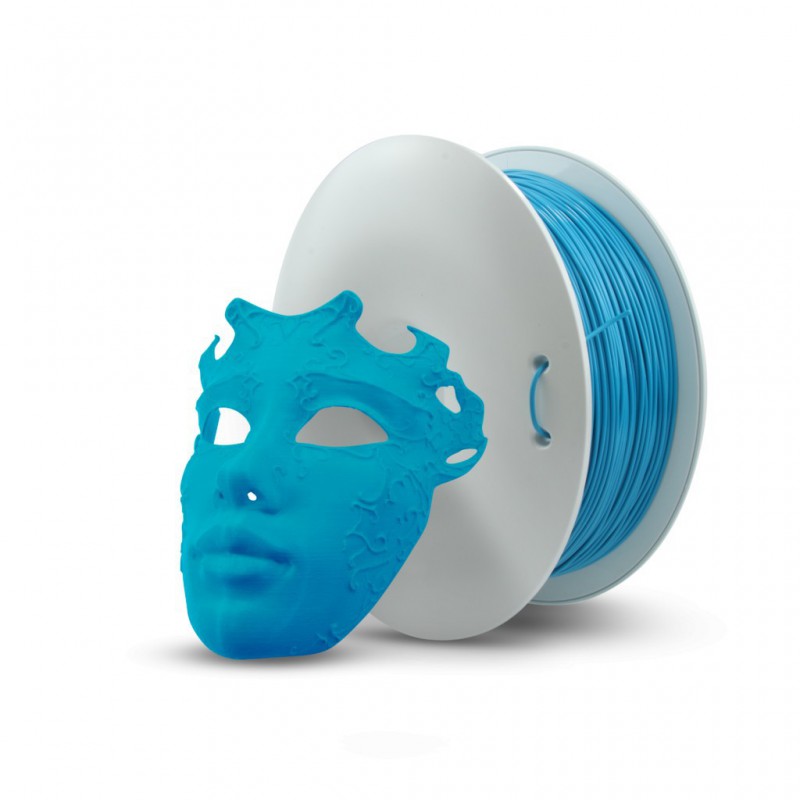 And since this material has safety certificates that allow it to be used in contact with food, it can be used as a consumable for printing dishes, various containers and toys. In the industrial sector, this material is used for the manufacture of bottles, as well as for high-quality prototypes of transparent dishes.
And since this material has safety certificates that allow it to be used in contact with food, it can be used as a consumable for printing dishes, various containers and toys. In the industrial sector, this material is used for the manufacture of bottles, as well as for high-quality prototypes of transparent dishes.
SBS plastic is also used for printing medical products. From it you can make lamps, as well as shades for them. Since SBS does not shrink and adheres perfectly to the desktop, this material is ideal for printing large layouts. This is an excellent material with which you can achieve a beautiful glass effect. Products made of SBS plastic are frost-resistant and resistant to aggressive substances such as alcohols, fats, acids and alkalis.
Main features of SBS plastic
SBS plastic is a flexible, transparent and safe material with good adhesion to paint. This plastic is easily machined and dyed, resulting in very bright and saturated colors. The composition does not include any toxins, so it is absolutely safe.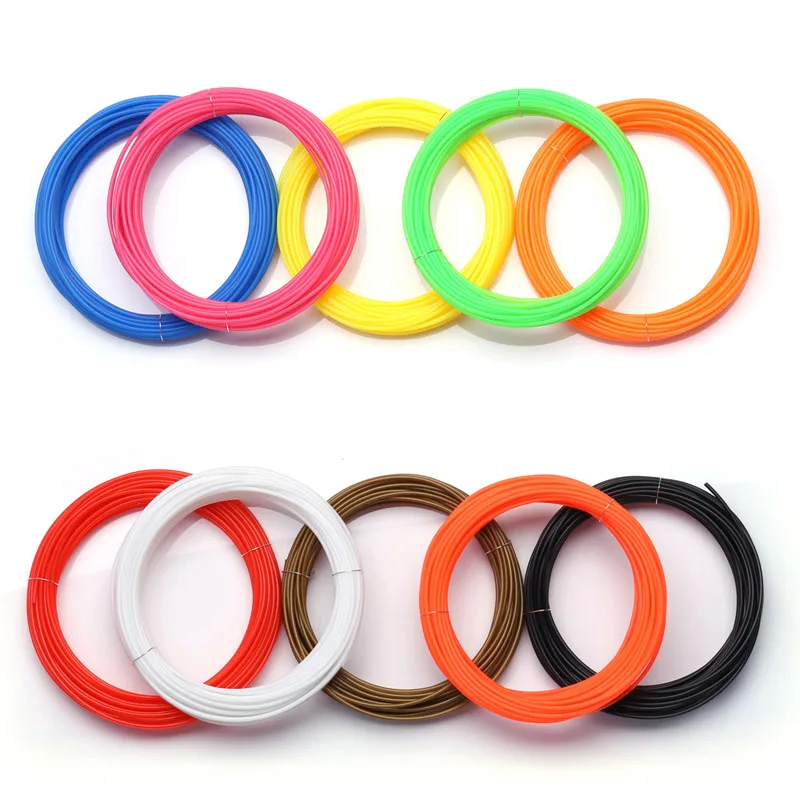
A characteristic feature of the material is the almost complete absence of shrinkage, which distinguishes it favorably from ABS plastic. In addition, SBS-plastic has the following technical characteristics:
Glass transition temperature 80-95°C
Softening point 76°C
Density 1.01 g/cm3
Moisture absorption 0.07%
Tensile modulus 1350MPa
Elastic modulus at break 1450MPa
Tensile strength at break 24MPa
Flexural strength 36MPa
Shore hardness 68
Rockwell hardness 118
Izod impact strength at 23°C 3.5kJ/m2
Transparency 90%
Minimum wall thickness 0.3mm
HIPS High impact polystyrene – + four
HIPS is a high-impact polystyrene, and to be precise, it is a copolymer of styrene with butadiene rubber. It is a safe material used for 3D printing. It combines the hardness of polyester with the elasticity of rubber. It is mainly used to form supporting structures, since during FDM printing the base material cannot lay down in the air and all overhanging elements must have a base under them.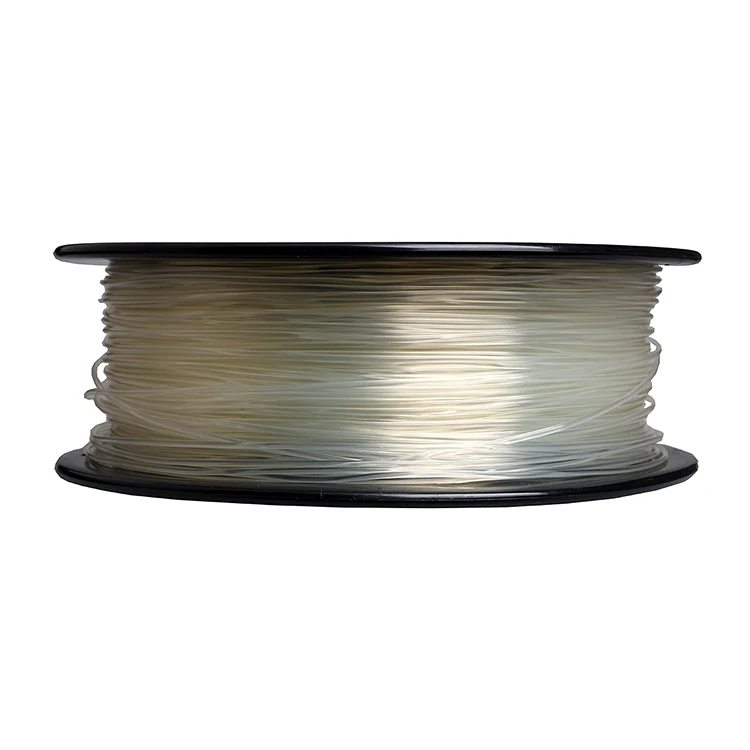 The material is used in tandem with ABS and is easily removed with limonene.
The material is used in tandem with ABS and is easily removed with limonene.
What is printed with HIPS?
HIPS can be used on its own, not just to support ABS printing. Since the characteristics of the material are in many ways similar to ABS, the use of HIPS plastic is approximately the same. It can be used for 3D printing of household items, toys and souvenirs, design elements and models. Details are softer, moderately plastic, easy to grind, refine, polish and paint. The material is safe, so it can be used for 3D printing of food containers, although in some cases residual styrene can be released in the form of toxic fumes at elevated temperatures. Compared to ABS plastic, HIPS has one undoubted advantage - it does not have strong heat shrinkage and is not prone to thermal deformation.
Characteristics of HIPS
HIPS plastic is characterized by the following qualities: light weight, moisture resistance, softness, haze. In addition, it is characterized by biostability and inertness to many chemical environments.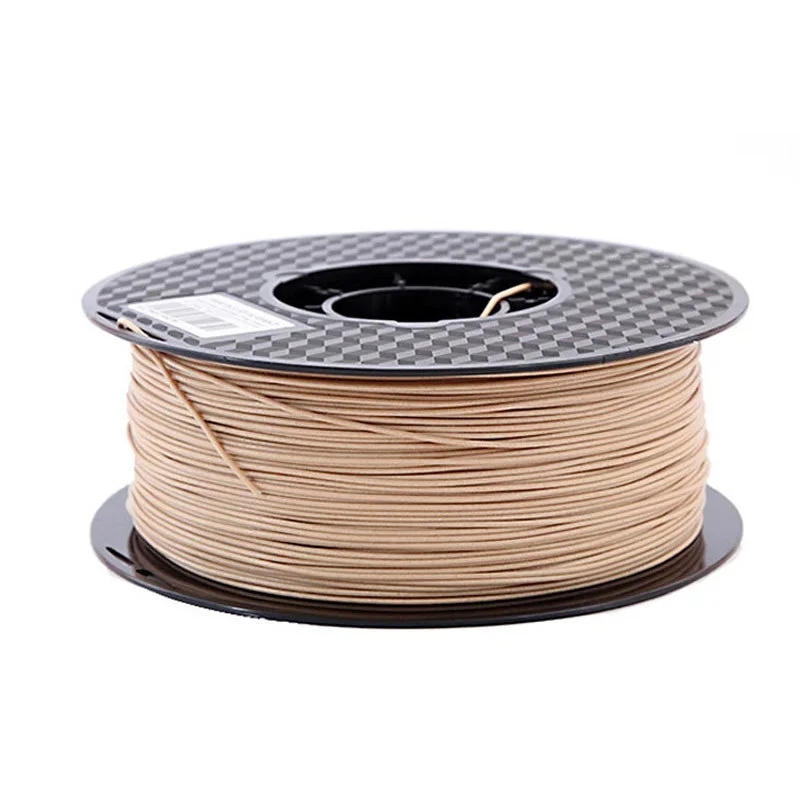 Due to safety, it is compatible with food products. The material can be used in a wide temperature range from -180 degrees to +80, has a slight heat shrinkage. In addition, HIPS has the following specifications:
Due to safety, it is compatible with food products. The material can be used in a wide temperature range from -180 degrees to +80, has a slight heat shrinkage. In addition, HIPS has the following specifications:
Extrusion temperature 230-240°C
Shrinkage 0.8%
Flexural modulus 2280MPa
Tensile strength 62MPa
Tensile elongation 4.8%
Flexural strength 33MPa
Elongation at break 65%
Density 1.05g/cm3
In our company, you can order 3D printing from HIPS thermoplastic. We guarantee you a perfect result in full accordance with your CAD file.
PVA Water Soluble Plastic – + 5
Polyvinyl alcohol, which is used in 3D printing called PLA plastic, is obtained from a wide variety of raw materials. For example, ethylene gas, which is released when apples ripen, ethyl alcohol and various petroleum products. PVA plastic is safe and completely non-toxic. But it is very hygroscopic, as it dissolves in water, so the main use of this material is the printing of supporting structures paired with nylon or PVA plastic.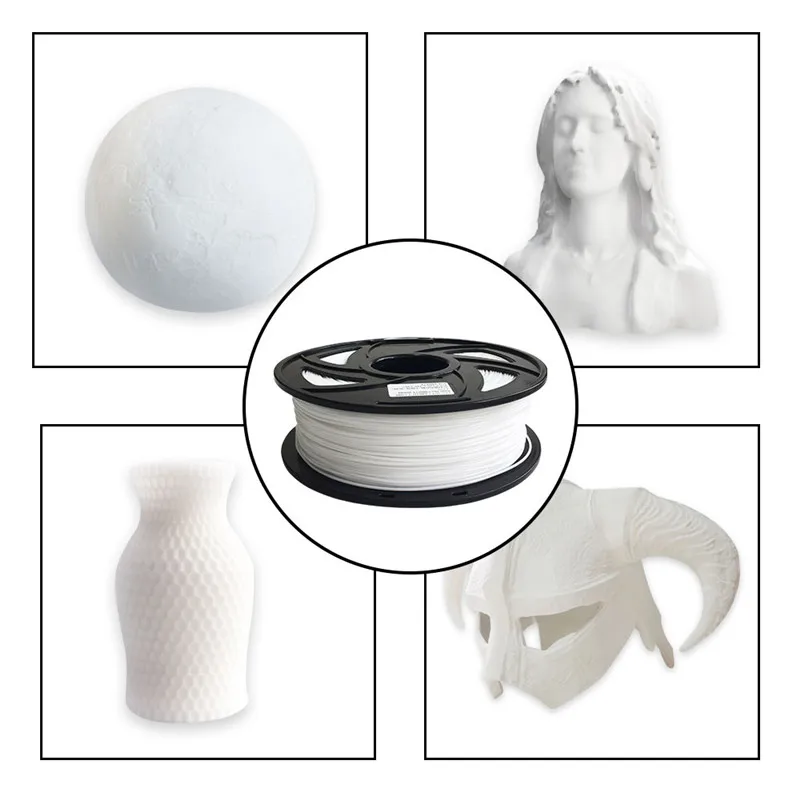 It can also be used with ABS plastic.
It can also be used with ABS plastic.
What is printed with PVA plastic?
As mentioned above, the main area of use of PVA plastic is supporting structures. After all, when printing using FDM technology, the material cannot lay down in the air, it needs some kind of foundation. After printing, the structures are easily dissolved in water, that is, they are removed as unnecessary. This material is not suitable for printing other items precisely because of its hygroscopicity.
Properties of PVA-plastic
PVA-plastic has interesting characteristics that depend on moisture, more specifically on air humidity. For example, its strength will directly depend on humidity indicators: the lower the humidity, the more durable the material will be. However, at higher moisture levels, the material will be more elastic.
Material may also ignite at temperatures above 175 degrees Celsius. In addition, PVA plastic has the following technical characteristics:
Melting point 190-200°C
Density 1.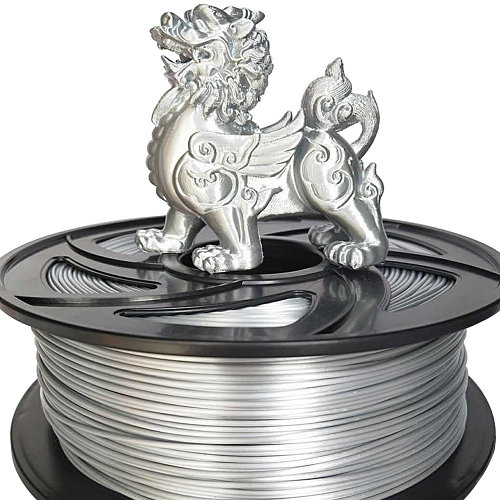 25-1.36g/cm3
25-1.36g/cm3
Specific heat capacity 0.4 J/K
Viscosity 22-30mPa
Polymerization 1680-1880
Temperature curing temperature 45-55°C
In our company you can order 3D printing from PVA thermoplastic. We guarantee you a perfect result in full accordance with your CAD file.
PETG Plastic - + 6
Glycol modified polyethylene terephthalate is a PETG plastic that is one of the most popular plastics in the world. This is the same polymer that is used in the production of bottles, containers and other containers. PET plastic is also found, which is characterized by greater fragility and less durability. In addition, PETG plastic is cleaner and safer. It is used in 3D printing, positioning itself as a cross between ABS plastic and PLA. It is easier to print with it than with ABS plastic, and in comparison with PLA, it is more plastic.
What is printed with PETG plastic?
PETG is a versatile material.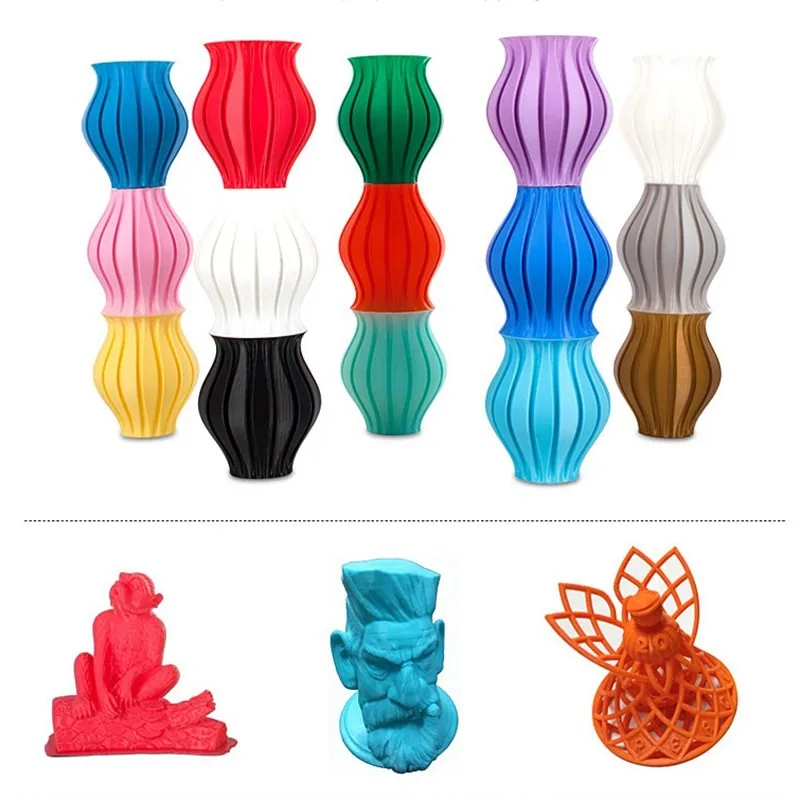 It is characterized by good rigidity, resistant to high temperatures. Therefore, it can be used in 3D printing of machine parts and mechanisms, housings and protective products. From this material you can create fasteners, organizers and tools. You can also use PETG plastic for 3D printing of toy souvenirs.
It is characterized by good rigidity, resistant to high temperatures. Therefore, it can be used in 3D printing of machine parts and mechanisms, housings and protective products. From this material you can create fasteners, organizers and tools. You can also use PETG plastic for 3D printing of toy souvenirs.
In principle, nothing limits the use of this material, because it is not in vain that it has become so widespread in the industrial field and in everyday life. This material is considered ideal for large models, as it is not prone to warping. In addition, PETG plastic is an excellent support material, that is, it can be used to create supports.
Properties of PETG plastic
PETG plastic is really a very strong material, strong and durable. Despite this, it is much easier to scratch it than the same ABS plastic. The latter, by the way, is more solid. It is less flexible and softer than ABS and PLA. For this reason, it is almost impossible to break a sample printed from PETG plastic.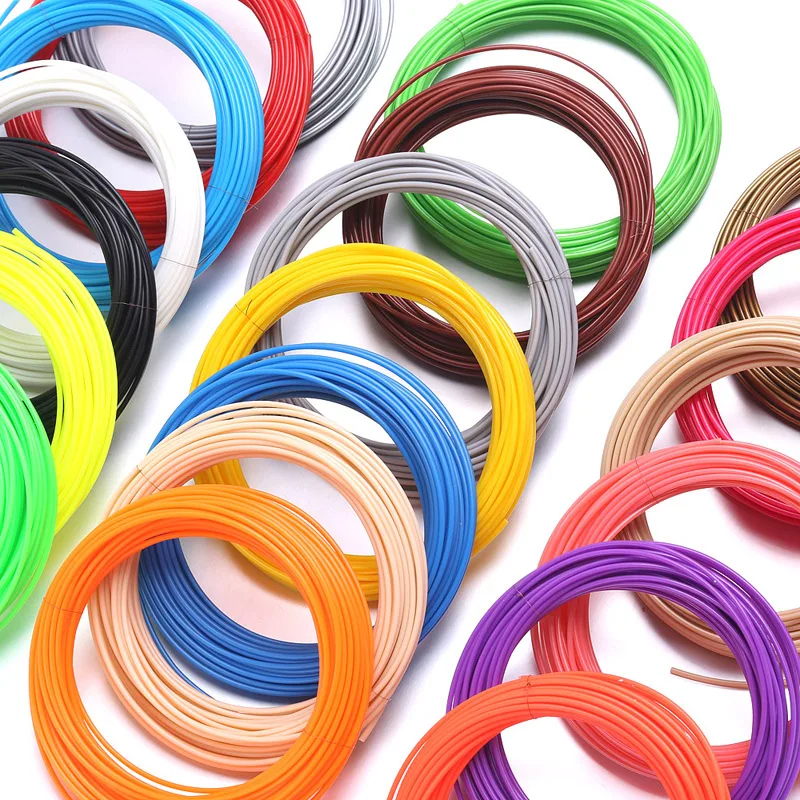 The degree of compression of the material is very low, so there is no deformation. PETG plastic is resistant to acids and alkalis, water and other aggressive media. Prints from it are incredibly durable. Also, the following technical characteristics are characteristic of PETG plastic:
The degree of compression of the material is very low, so there is no deformation. PETG plastic is resistant to acids and alkalis, water and other aggressive media. Prints from it are incredibly durable. Also, the following technical characteristics are characteristic of PETG plastic:
Glass transition temperature 80°C
Density 1.27 g/cm3
Water absorption in 24h Less than 0.1%
Tensile strength 50MPa
Flexural strength 36MPa
Rockwell hardness 106
Light transmittance 88%
Maximum operating temperature
In our company you can order 3D printing from PETG thermoplastic. We guarantee you a perfect result in full accordance with your CAD file.
FLEX Rubber-like plastic - + 7
Consumable for 3D printing FLEX or Flexible PolyEster is a flexible plastic that allows using FDM 3D printing technology to create products of complex configuration with flexible elements. This type of material for 3D printing is very similar in its properties to ordinary rubber. It is one of the most resilient and flexible filaments and opens up new possibilities and applications for additive manufacturing. It is an elastic material, resistant to mechanical processing, but tactilely pleasant.
This type of material for 3D printing is very similar in its properties to ordinary rubber. It is one of the most resilient and flexible filaments and opens up new possibilities and applications for additive manufacturing. It is an elastic material, resistant to mechanical processing, but tactilely pleasant.
What is printed with FLEX plastic?
Using FLEX plastic, you can print rubber-like parts for equipment and machines, elastic elements of clothing and footwear, toys. Such an application is due to the highest wear resistance of the material.
FLEX plastic can be used to print complex models. These can be souvenirs, masks and even medical prostheses. In general, this type of 3D printing plastic is applicable wherever flexible parts are required.
FLEX 9 properties0018
The main characteristics of FLEX plastic are a wide color palette, resistance to mechanical stress and aggressive environments, and a high melting point. Since the material is produced exclusively from natural materials (corn), it is environmentally friendly and safe.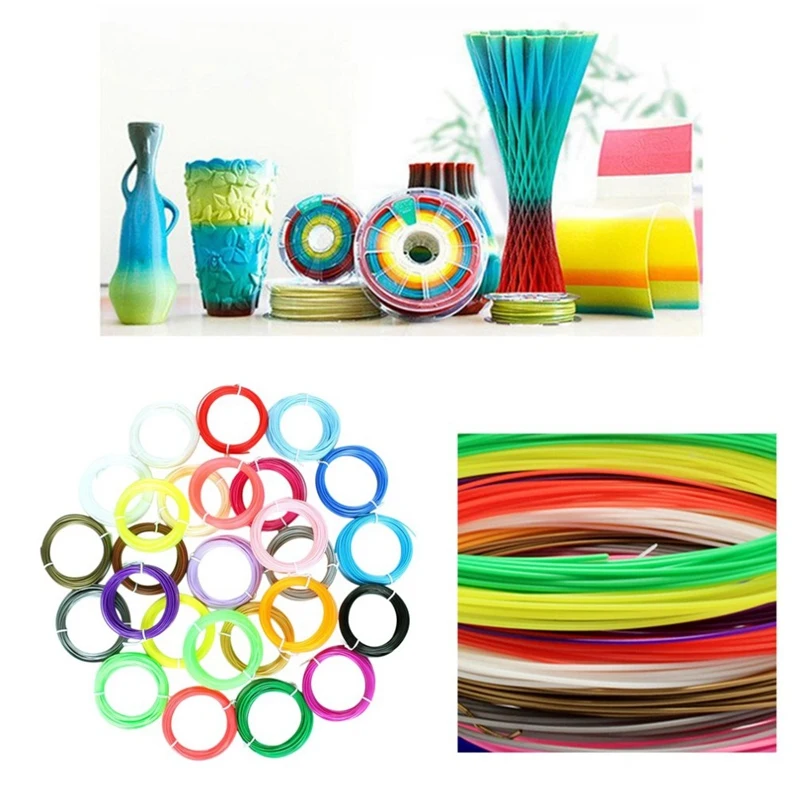 FLEX plastic can be glued with a building hair dryer or synthetic rubbers. Also, products made from this material are characterized by high strength and heat resistance. 3D printing with FLEX plastic has some difficulties, although if you have experience, all problems are easily solved.
FLEX plastic can be glued with a building hair dryer or synthetic rubbers. Also, products made from this material are characterized by high strength and heat resistance. 3D printing with FLEX plastic has some difficulties, although if you have experience, all problems are easily solved.
This is a biodegradable material which, in addition to the above, has the following technical characteristics:
Density 1.1 g/cm3
Tensile modulus 63.7 MPa
Maximum bending load 8N
Compressive strength 7.6 MPa
Elongation at break 600 %
Bending strength 5.3 MPa
Shore hardness 40
In our company you can order 3D printing from FLEX thermoplastic. We guarantee you a perfect result in full accordance with your CAD file.
RUBBER Rubber-like plastic – + eight
RUBBER
Filament is the so-called rubber for 3D printing. The characteristics of this thermoplastic resemble rubber in many ways.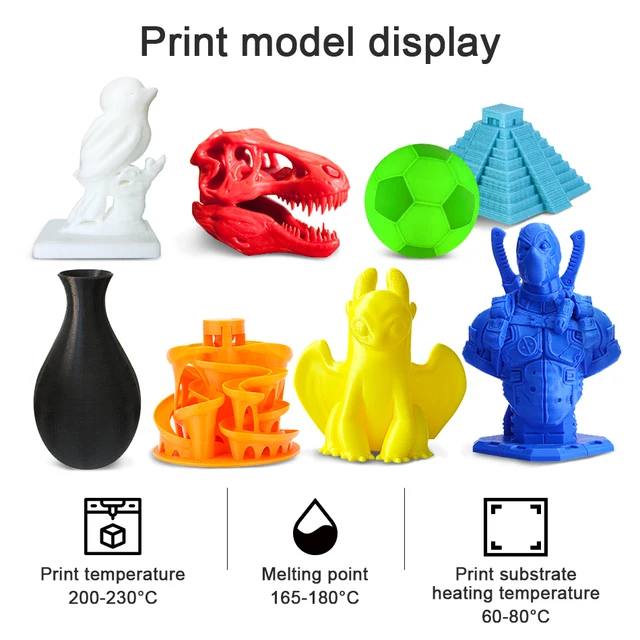 This is the most rubbery of all existing filaments for 3D printing using FDM technology.
This is the most rubbery of all existing filaments for 3D printing using FDM technology.
What does RUBBER print?
RUBBER thermoplastic is best suited for printing anything normally made from rubber. These are buttons, seals. You can also use the filament to 3D print tires, toy car wheels, and radio-controlled models. RUBBER is used for the additive manufacturing of shock absorbers, vibration damping pads and other parts that typically contain rubber elements. Due to the fact that the filament is practically chemically inert, it can be used where others can react, deform or even dissolve.
Properties of RUBBER thermoplastic
As mentioned earlier, RUBBER plastic is identical in its qualities to the usual popular rubber. It even comes in black. Among the pronounced properties, one can distinguish the highest degree of strength, the material is difficult to machine and does not enter into a chemical reaction with essential oils.
A soldering gun can be used to bond RUBBER parts.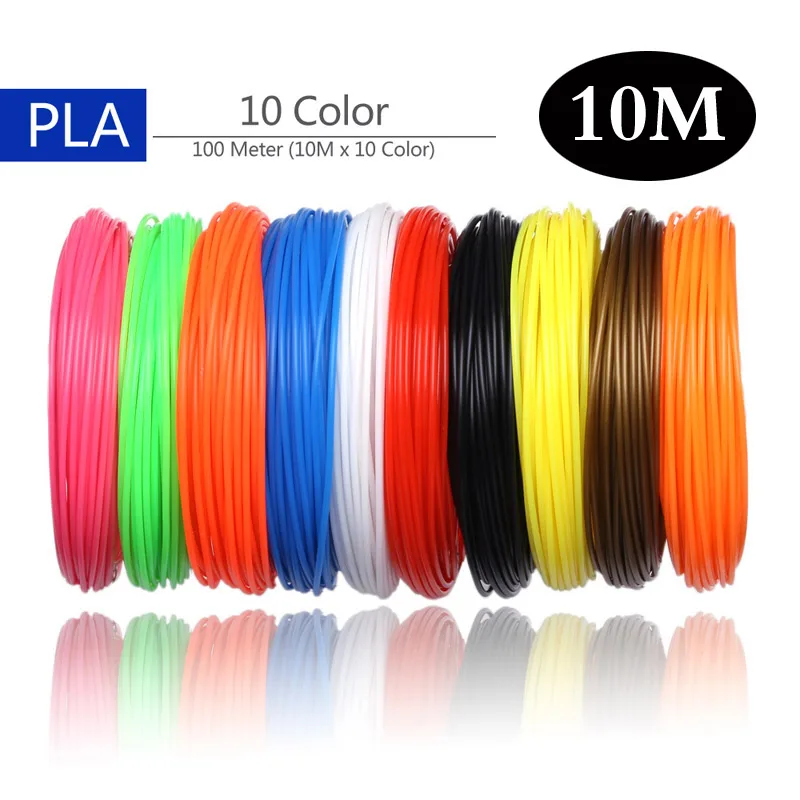 In addition, gluing can be done using synthetic rubbers.
In addition, gluing can be done using synthetic rubbers.
The specifications of RUBBER thermoplastic are as follows:
Density 0.95 g/cm3
Bending strength 3.4 MPa
Maximum bending load 5N
Maximum tensile load 365N
Operating temperature -40 +85
Compressive strength 2.3 MPa
Elongation at break 500%
Izod impact strength 25 kJ/m2
Shore hardness 60
In our company you can order 3D printing from RUBBER thermoplastic. We guarantee you a perfect result in full accordance with your CAD file. All the difficulties of 3D printing from this plastic will fall on our shoulders, which will allow you to save time and guarantee the highest quality result
NYLON Plastic – + 9
Nylon is one of the popular families of synthetic polymers used in various industries. In the field of 3D printing, this material is perceived as a kind of heavyweight. If we compare this material with others, then it has more balanced indicators of flexibility, rigidity and durability.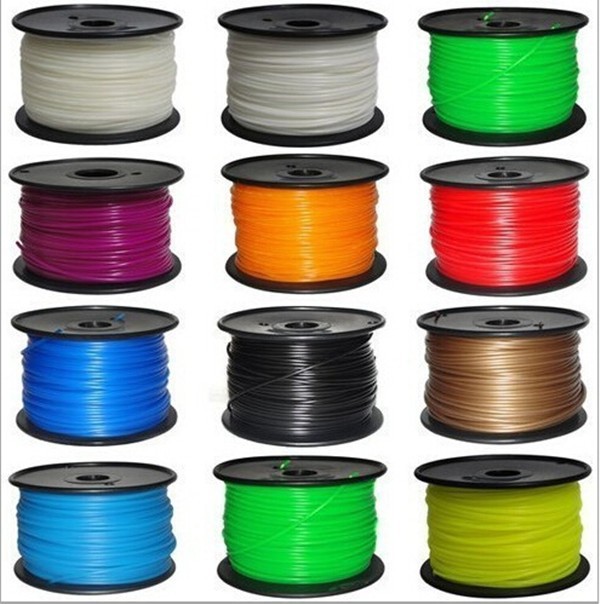 A special quality of Nylon is the ability to color the material both before and after 3D printing. This material varies by grade, but 3D printing typically uses 618 and 645 Nylon.
A special quality of Nylon is the ability to color the material both before and after 3D printing. This material varies by grade, but 3D printing typically uses 618 and 645 Nylon.
What is printed from Nylon?
Nylon in 3D printing has received the same wide application as in the industrial field. Given its flexibility, long service life, and material rigidity, it is used for 3D printing of functional prototypes, various mechanical components and parts, such as gears. Nylon is used to print a variety of instruments, including medical ones. In general, this material is highly versatile and applicable to a wide range of tasks. And due to the fact that Nylon has a very low coefficient of friction, it is ideal for 3D printing moving parts. For example, you can print a sleeve for an axle rotating at low speeds, a bearing is not inapplicable in places, or gears that do not need lubrication.
Nylon has a high tensile strength, which makes it suitable for printing fasteners in the form of clamps and ropes.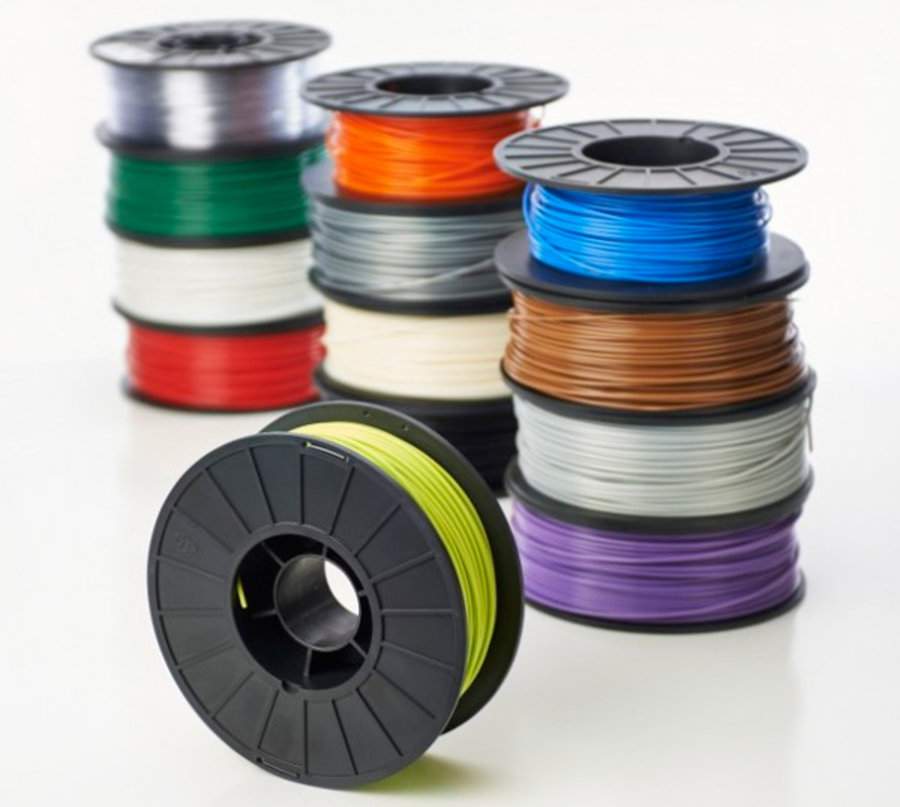 The disadvantage of nylon is its hygroscopicity. This material is able to absorb up to 10% of its own weight of water per day, although this will largely depend on the grade of nylon used.
The disadvantage of nylon is its hygroscopicity. This material is able to absorb up to 10% of its own weight of water per day, although this will largely depend on the grade of nylon used.
Specifications Nylon
The material is characterized by high strength and flexibility, as well as a very long service life. In addition, Nylon is a safe material from an environmental point of view, characterized by acceptable heat shrinkage and deformation. In addition, Nylon has the following technical characteristics:
Glass transition temperature 49.4-68.2°C
Melting point 2014-218°C
Density 1.134 g/cm3
Moisture absorption 3.09%
Tensile strength 65.99MPa
Elongation at break over 300%
nylon is characterized by resistance to any organic solvents, elasticity and wear resistance. But during pyrolysis, this material is capable of releasing toxic fumes. Coloring of the material is possible with the help of acid dyes.
PC Polycarbonate – + ten
Polycarbonate is a high-strength engineering thermoplastic that is widely used as a replacement for glass.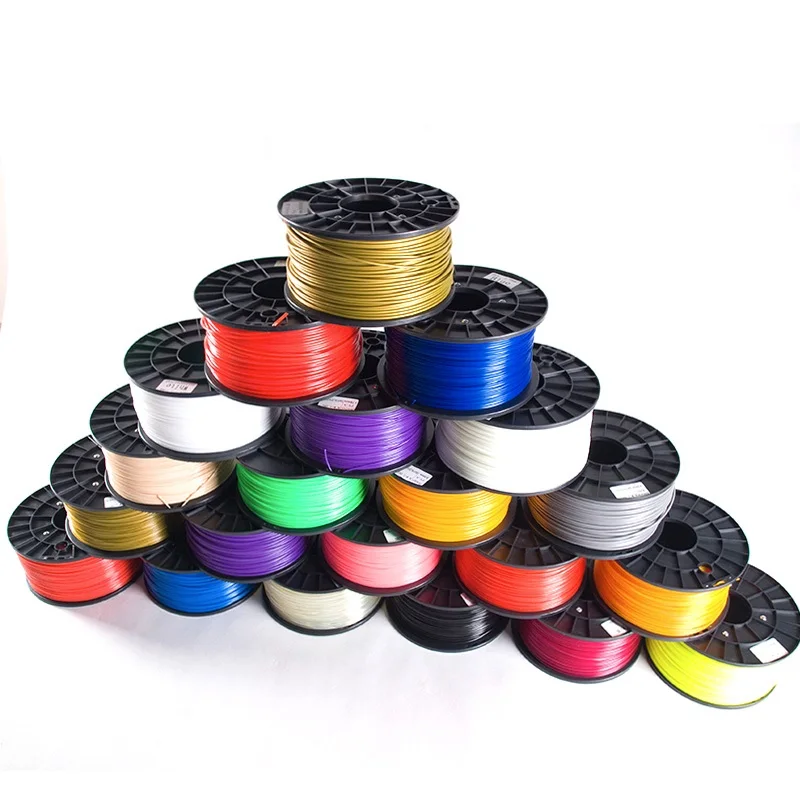 In terms of strength, it surpasses it by 250 times. In 3D printing, Polycarbonate is used quite rarely, since the technology for its use is still imperfect, there are some difficulties. But due to the characteristics of this material is becoming more widespread.
In terms of strength, it surpasses it by 250 times. In 3D printing, Polycarbonate is used quite rarely, since the technology for its use is still imperfect, there are some difficulties. But due to the characteristics of this material is becoming more widespread.
What is printed from Polycarbonate?
Polycarbonate is used for 3D printing goggles, helmets and other protective equipment, as it combines transparency and the highest strength. Since such a compound as bisphenol is used in the production of polycarbonate, despite the safety of the material itself, it is still not recommended to use the material for printing food containers, especially hot ones. Since it is at elevated temperatures that residual bisphenol can be released. And this compound is highly toxic and even in microscopic doses can contribute to cancer.
Due to the extreme strength of polycarbonate, various structural models, functional prototypes, as well as working parts of various mechanisms and tools can be printed from it.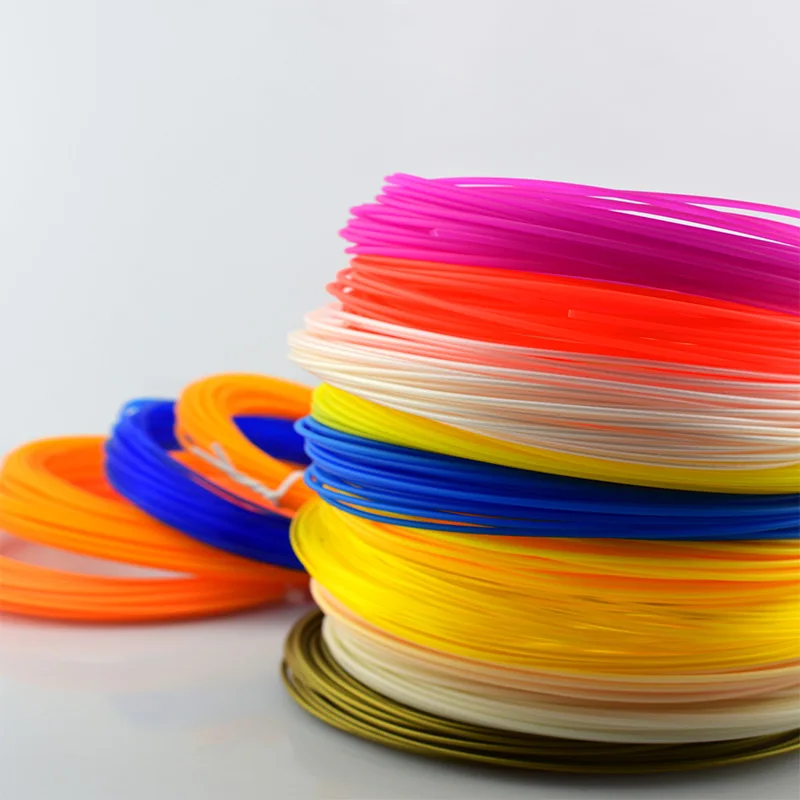 This material is recommended for 3D printing of products that need to hold their shape and rigidity well at elevated temperatures. These can be electrical components, lighting fixtures, etc.
This material is recommended for 3D printing of products that need to hold their shape and rigidity well at elevated temperatures. These can be electrical components, lighting fixtures, etc.
Characteristics of Polycarbonate
The most important qualities that distinguish Polycarbonate are strength, wear resistance, resistance to a wide temperature range from -100 to +130 degrees Celsius. In 3D printing, Polycarbonate is able to guarantee the highest precision and stability. In addition, polycarbonate is characterized by high rigidity and impact strength. The material is soluble in chloroform, tetrachloroethane, meta-cresol and ethylene chloride. Polycarbonate is a hygroscopic material and is not resistant to UV radiation.
Polycarbonate specifications are as follows:
Glass Transition Temperature 161°C
Softening Temperature 139°C
Tensile Modulus 1.944 MPa
Tensile Strength 68 MPa
Tensile Elongation 4.8%
Flexural Strength 13 MPa 90 /m
Transparency 90%
POLYAMIDE (for SLS printing) – + eleven
When printing using selective laser sintering technology, a thermoplastic polymer polyamide is used.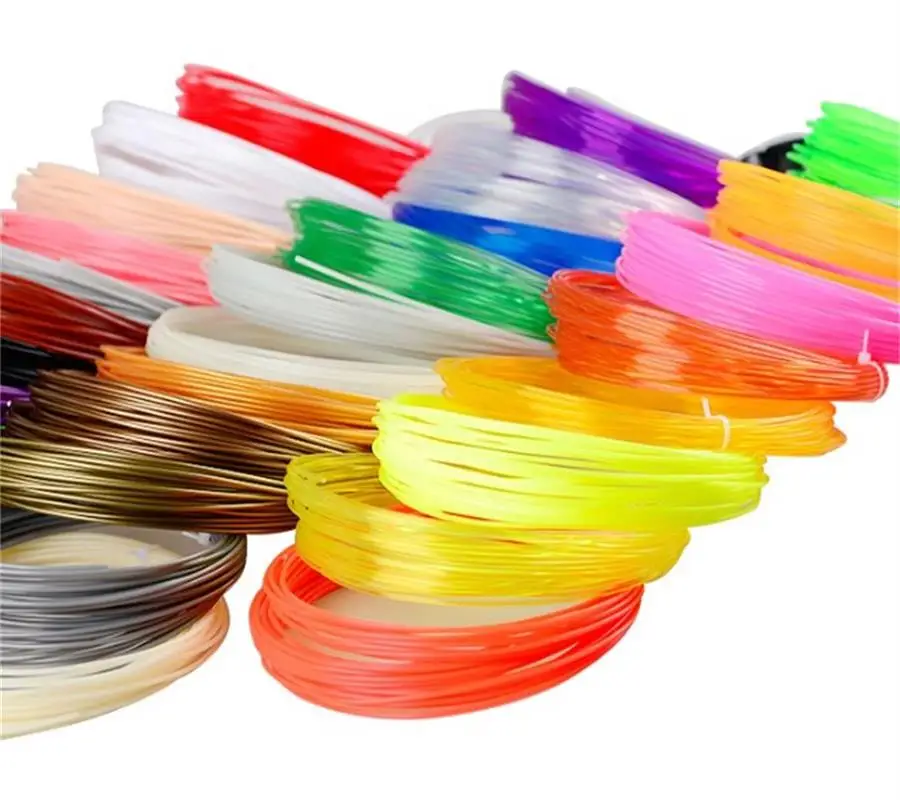 This material has high rigidity and strength. And in combination with printing technology, it allows to obtain high-precision, detailed products of the most complex geometry (accuracy reaches 60 microns). There is no need for supports, which makes post-processing virtually unnecessary. The material is in the form of a white granular nylon powder.
This material has high rigidity and strength. And in combination with printing technology, it allows to obtain high-precision, detailed products of the most complex geometry (accuracy reaches 60 microns). There is no need for supports, which makes post-processing virtually unnecessary. The material is in the form of a white granular nylon powder.
What is printed from polyamide?
SLS polyamide can be used to print conceptual design objects and complex geometric models. This material can be used to create fully functional plastic parts. Thus, printing with polyamide is in demand in the medical field, industrial engineering, instrument manufacturing and design.
Products printed from polyamide are characterized by a rough surface and need to be sanded to make them smooth.
This material is considered ideal for printing phone cases, figurines and gadgets, lamps and various costume jewelry. That is, in principle, it is a fairly universal material, applicable almost everywhere.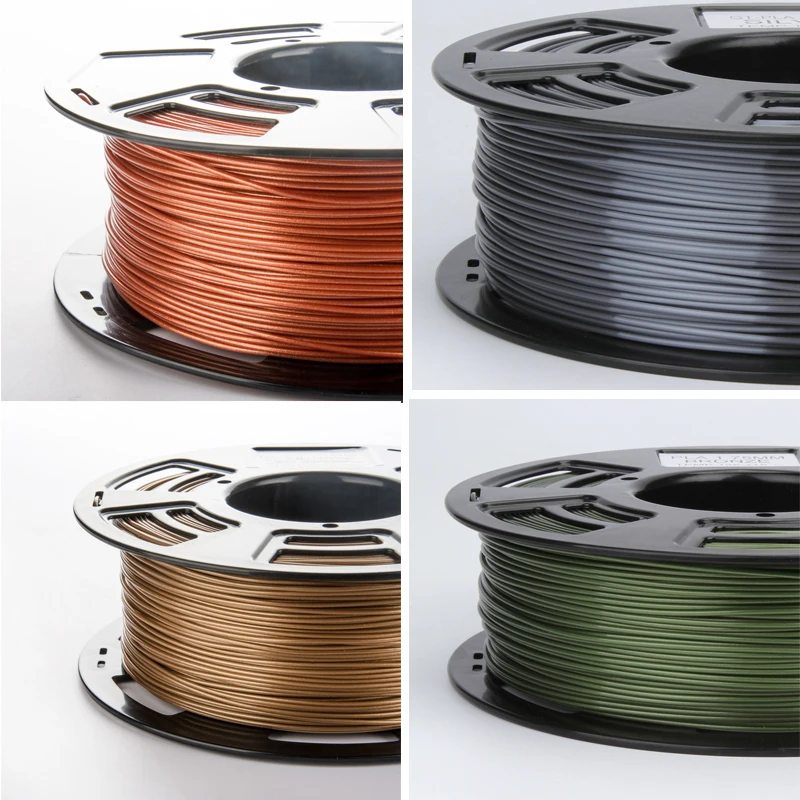 However, it is not moisture resistant and therefore products made from it cannot be used outdoors. If, nevertheless, there is a need to use a part printed from polyamide in the open air, it must be covered with moisture-resistant paint.
However, it is not moisture resistant and therefore products made from it cannot be used outdoors. If, nevertheless, there is a need to use a part printed from polyamide in the open air, it must be covered with moisture-resistant paint.
Polyamide properties for 3D printing
Polyamide originally white material that can be dyed in several colors. This polymer is not approved and therefore cannot be used for foodstuffs. Polyamide itself and products made from it printed on a 3D printer are distinguished by the following qualities: strength, rigidity. It is characterized by sufficient flexibility, which will depend on the thickness of the walls: the thicker the wall, the less flexible the part will be.
In addition, polyamide parts are chemically and mechanically resistant.
Polyamide has the following technical characteristics:
Tensile strength 48 MPa
Flexural strength 58 MPa
Softening point 160 °C
Melting point 180 °C
Density 0.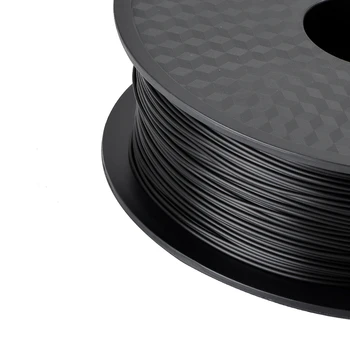 93 g/cm3
93 g/cm3
Surface appearance matt, slightly porous and rough
PHOTOPOLYMER RESIN - + 12
Resin SLA
SLA 3D printing resins are a liquid pigmented resin that turns into a solid plastic-like material when exposed to an ultraviolet laser. This material and technology make it possible to obtain highly detailed and high-precision products (up to 30 microns). There are material variations that allow you to imitate different types of plastic (for example, ABS) and even rubber-like material.
What is printed with SLA
Resin With SLA technology, almost anything can be printed from photopolymer resin. Due to the accuracy and high speed of printing, this material, like the technology, has become in demand in the jewelry and dental industries. Many photopolymer resins are biocompatible and therefore are actively used in the medical field - 3D printing of accurate models of prostheses and implants is carried out.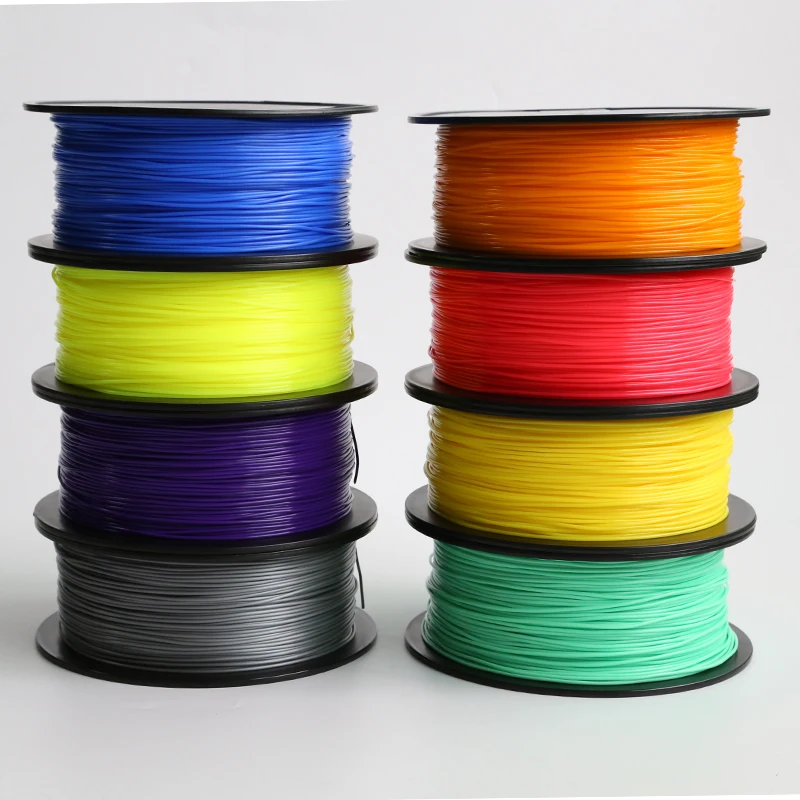
SLA photopolymer is in demand in the industrial field, for 3D printing of thin and complex design works, presentation and visual materials. If it is necessary to print a complex object with overhanging details, supports are used that are printed from a special material and can be easily removed by hand or in a special solution.
Products printed with SLA photopolymer have a smooth surface and therefore require little to no rework, except for the removal of supports, if any. The characteristics of the material and technology allow 3D printing of complex moving mechanisms and their parts.
SLA Resin Properties
SLA Resin performance will largely depend on the specific resin, brand, etc. Basically, these are properties that resemble ABS plastic. That is, high strength, durability, wide color palette. In addition, these materials have high thermal stability. The main technical characteristics of SLA photopolymers are as follows:
Composition UV-cured acrylic plastic
Tensile strength 49 MPa
Elongation at break 8.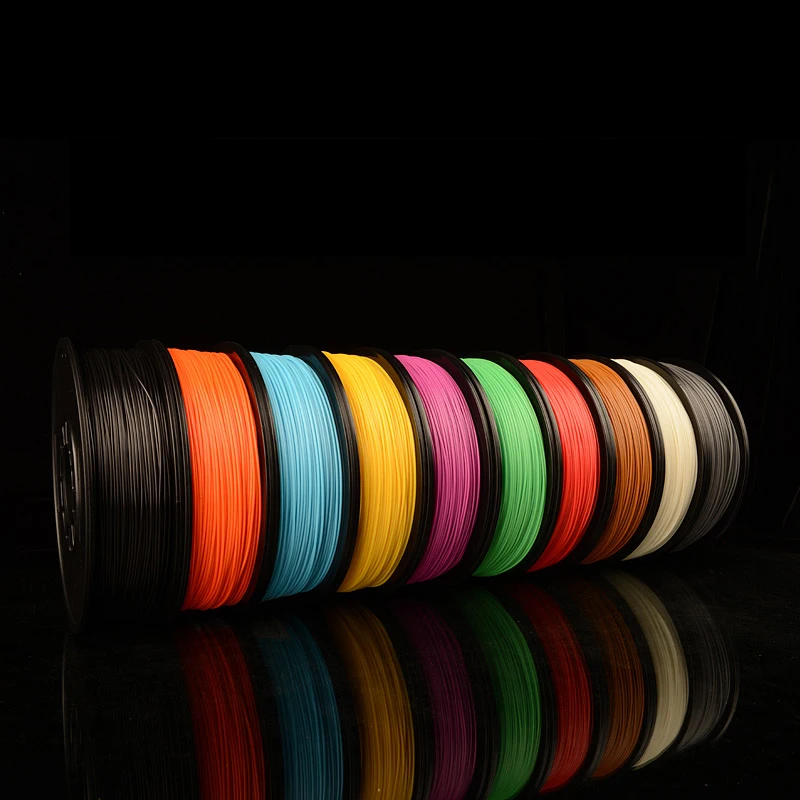 3%
3%
Deformation temperature at 0.45 MPa 88 °C
Density at 80 °C (liquid) 1.04 g/ cm3
Tensile modulus 2168 MPa
Flexural strength 65 MPa
GYPSOPOLYMER - + 13
Multicolor plaster
Gypsum is one of the most affordable materials used in 3D printing and the only one that allows you to get prints of photorealistic accuracy. Moreover, the technology does not require the use of supports and allows you to reuse unused material.
What is printed with multicolor plaster?
This is an ideal material for 3D printing all kinds of figurines, characters, architectural and landscape models. It is suitable for creating any objects that are oriented to static use, that is, those that do not imply intensive and active use. This is mainly a variety of souvenirs and decorative items for interior design. For exterior use of plaster models, they must be subjected to additional processing, as the material absorbs moisture and collapses.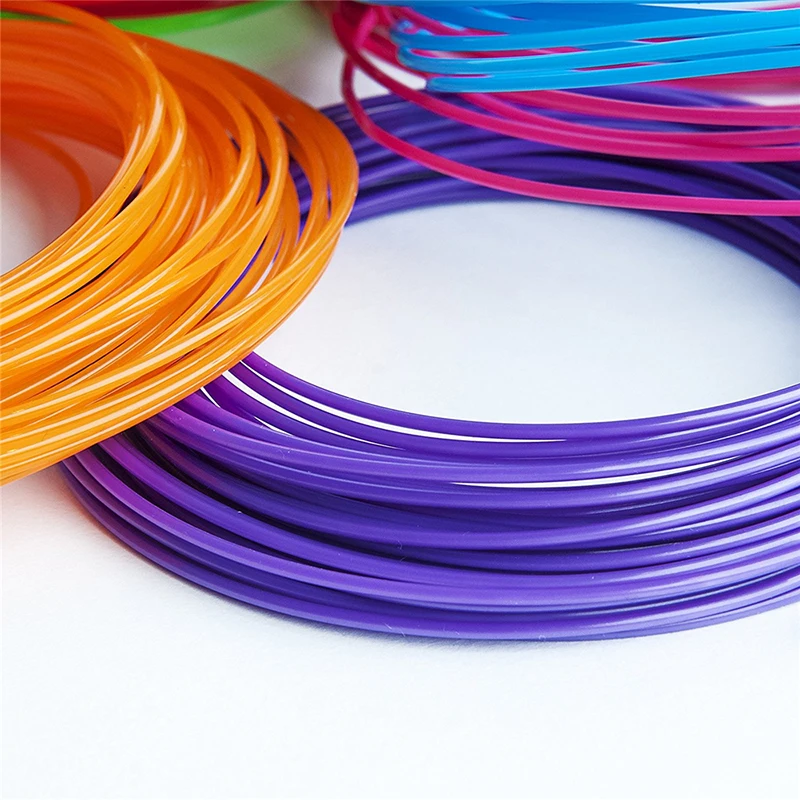
Another area of application for prints is advertising and marketing. It is also possible to print molds.
Properties of Colored 3D Printing Plaster
In general, multicolor 3D printing plaster can be characterized as a hard, rigid and somewhat brittle material with a high degree of hygroscopicity. The surface of the prints is rough and requires a protective coating to maintain its original qualities. Products made of multi-color gypsum after printing can be sanded, painted, drilled and glued if necessary. In addition to all this, the material has the following technical characteristics:
Palette of 16.7 million colors
Resolution 600 x 540 dpi
Detailing 0.1 mm
Minimum wall thickness 1.6 mm
Heat resistance up to 60°C
In our company you can order online 3D printing with multicolor plaster. We guarantee you high quality and full compliance with the provided virtual 3D model.
VT6 Titanium based alloy powder – + fourteen
Titanium-based powder alloy combines excellent physical characteristics and excellent appearance.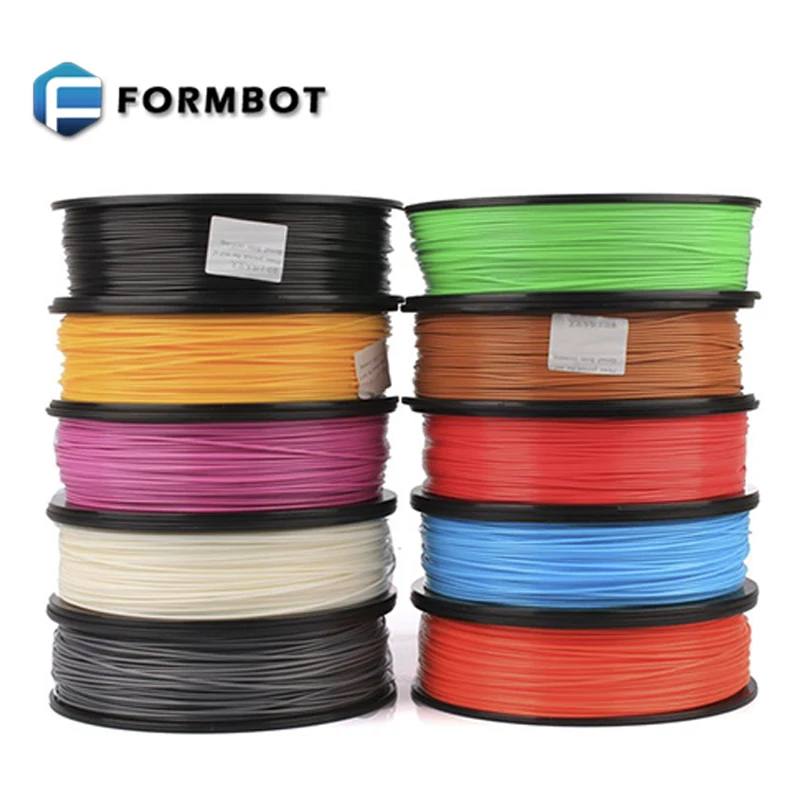 In 3D printing, this material is sintered with a laser. Products that are printed from titanium are different from those cast from this metal. They have a somewhat rough surface and lack a characteristic sheen. The chemical composition of this material is determined by ASTM F136-02a (ELI Grade 23). According to it, titanium acts as a base in the composition, and is also present in the corresponding mass fractions of Al - 5.5-6.5, V - 3.5-4.5, Fe - 0-0.25, C - 0-0 .8, 0-0.13, N - 0-0.05, H - 0-0.012.
In 3D printing, this material is sintered with a laser. Products that are printed from titanium are different from those cast from this metal. They have a somewhat rough surface and lack a characteristic sheen. The chemical composition of this material is determined by ASTM F136-02a (ELI Grade 23). According to it, titanium acts as a base in the composition, and is also present in the corresponding mass fractions of Al - 5.5-6.5, V - 3.5-4.5, Fe - 0-0.25, C - 0-0 .8, 0-0.13, N - 0-0.05, H - 0-0.012.
What is printed with titanium?
Using SLM technology, titanium powder is used to print products for the medical industry (instruments, implants, prostheses and their parts). Including products can be part of bionic components. In addition, the material is used for 3D printing of parts for marine machinery and equipment, aerospace and automotive components.
3D printed titanium alloy parts are lightweight, and this also has a direct impact on the applicability of the technology.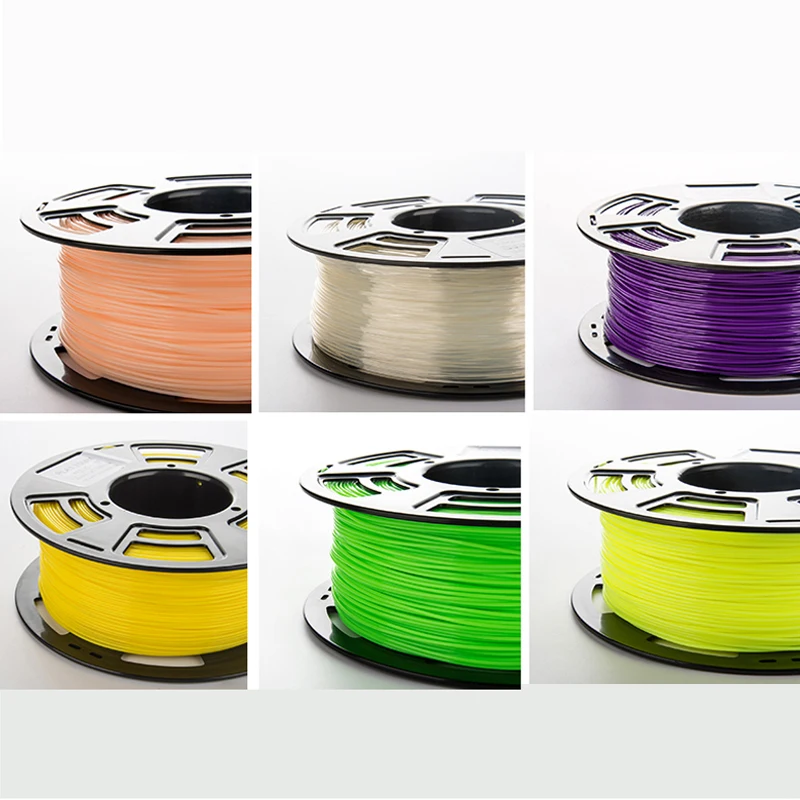 The alloy is characterized by a number of qualities that allow it to be used for printing components for internal cooling systems.
The alloy is characterized by a number of qualities that allow it to be used for printing components for internal cooling systems.
Properties of titanium for 3D printing
Titanium is a metal, so it is primarily characterized by the highest strength. At the same time, the material has a low density. It is a biocompatible material with high corrosion resistance. In addition, the titanium alloy is characterized by a low coefficient of thermal expansion. The material specifications are as follows:
Yield strength Re 900 - 1200 N/mm2
Tensile strength Rm 1100-1300 N/mm2
Elongation A 5-10%
Young's modulus approx. We guarantee you high-quality, precise execution in full accordance with the provided CAD model.
ALSI12 Aluminum powder alloy – + fifteen
3D printing uses aluminum-silicon powder, which is sintered into a single part using a 3D printer and SLS technology. This powder alloy has a composition according to DIN EN 1706 AlSi12(a). It is based on aluminum. The following chemical elements are also present in the corresponding mass fractions:
This powder alloy has a composition according to DIN EN 1706 AlSi12(a). It is based on aluminum. The following chemical elements are also present in the corresponding mass fractions:
• Si - 10.5-13.5
• Mg - 0-0.05
• Fe - 0-0.55
• Mn - 0-0.35
• Ti - 0-0.15
• Cu - 0-0.05
• Zn - 0-0.10
• C - 0-0.05
• Ni - 0-0.05
• Pb - 0-0.05
• Sn - 0-0, 05
What is printed with aluminum?
In fact, powdered aluminum alloy is a fairly versatile material. It is focused on parts that will be operated under conditions of high mechanical and dynamic loads. Thus, the alloy is most widely used in the aerospace industry, in industry and in the automotive industry. It is an ideal material for printing lightweight products. On its basis, single products are printed, and small-scale production of various models and parts is carried out.
Properties of aluminum for 3D printing
Aluminum powder alloy products are characterized by a uniform and dense structure.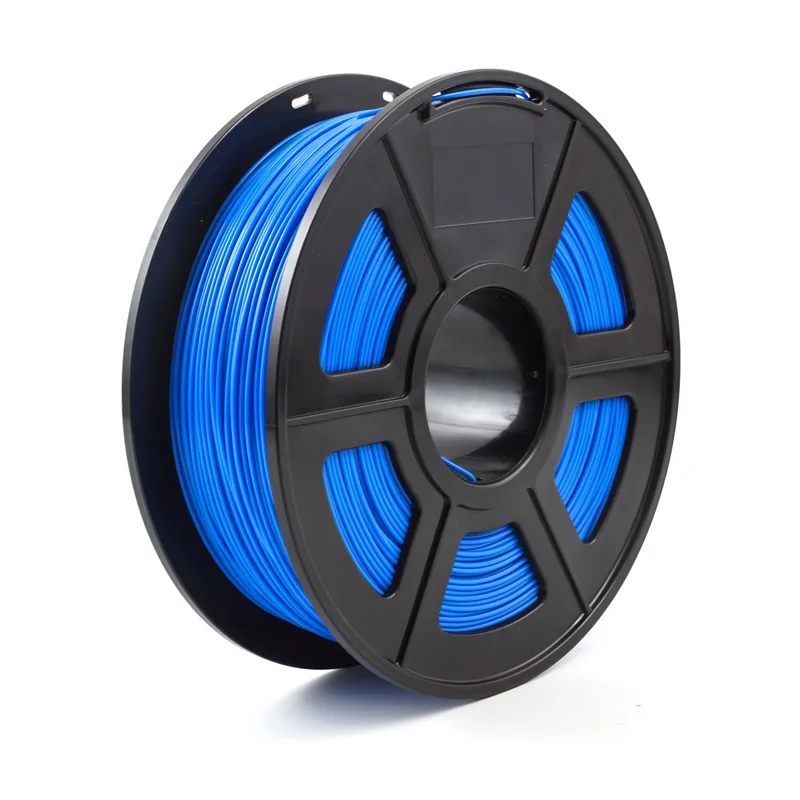 In addition, it is a material characterized by low weight and corrosion resistance. In addition, aluminum alloy has excellent alloying properties, processability and good electrical conductivity. Aluminum powder alloy has the following specifications:
In addition, it is a material characterized by low weight and corrosion resistance. In addition, aluminum alloy has excellent alloying properties, processability and good electrical conductivity. Aluminum powder alloy has the following specifications:
Yield strength Re 170-220 N/mm2
Tensile strength Rm 310-325 N/mm2
Elongation A 2 -3%
Young's modulus approx. 75x103 N/mm2
Thermal conductivity λ 120-180 W/m*K aluminum alloy powder. We guarantee you high-quality, precise execution in full accordance with the provided CAD model.
316L Stainless steel - + 16
One of the most common metals for 3D printing is steel. Its various alloys allow solving problems of the widest range. The most demanded powder alloy, which corresponds to the steel grade 1.4404, X 2 CrNiMo 17 13 2, 316L. This is a material that belongs to the austenitic grade and is mainly used for prototype products for pre-series production.
What is printed with steel?
Powdered stainless steel allows 3D printing to create prototypes used in automotive, modeling and small-scale production.
This material is also in demand in jewelry, the medical field and design. In general, powdered stainless steel is quite versatile in applications, and its characteristics allow the material to be used in any area.
Properties of powdered stainless steel
The material allows printing products that are resistant to acid attack and corrosion. In addition, this material is characterized by the highest strength and equally high wear resistance. The chemical composition of the powder steel alloy may vary slightly. Our company mainly uses CL20 ES steel, which is characterized by the following composition: the base is Fe, and the rest of the composition in the appropriate mass fractions of
Cr - 16.5-18.5
Ni - 10.0-13.0
Mo - 2.0-2.5
Mn - 0-2.0
Si - 0-1.0
P - 0 -0.045
C - 0-0.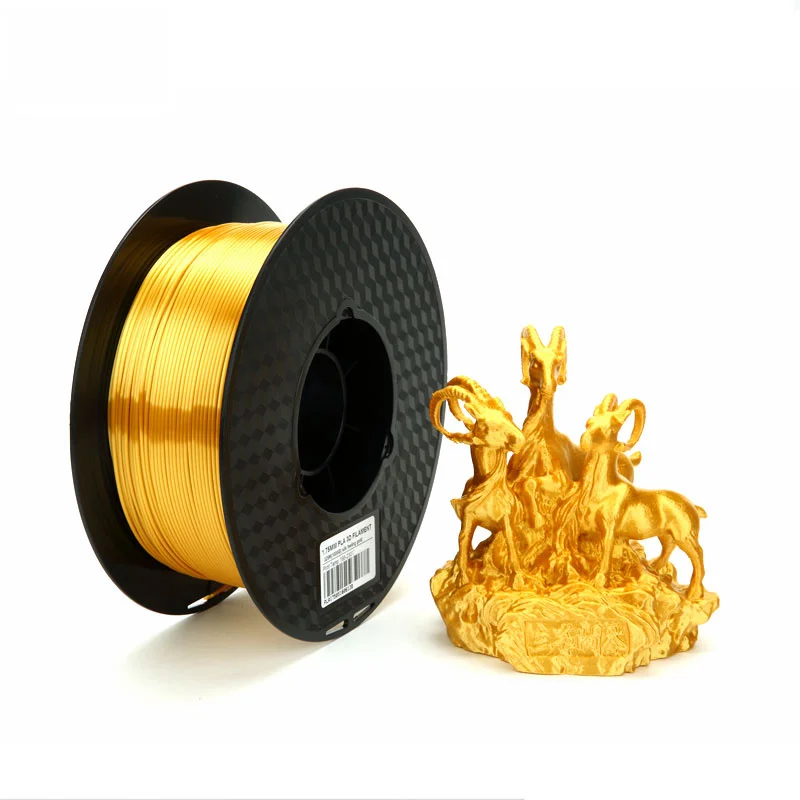 030
030
S - 0-0.030
Powdered stainless steel specifications are as follows:
Yield strength Re 470 N/mm2
Tensile strength Rm 570 N/mm2
Elongation A >15%
Young's modulus approx. 200x103 N/mm2
Thermal conductivity λ approx. 15 W/m*K
Hardness 20 HRC
In our company you can order stainless steel 3D printing. We guarantee you high quality and full compliance with the provided virtual 3D model.
COCR Powder alloy based on cobalt, chromium and vanadium – + 17
This type of material is focused mainly on the dental industry. This powdered metal alloy is called Remanium® Star CL. It is based on cobalt, chromium and vanadium. It is a certified material produced according to DIN EN ISO 9693 / DIN EN ISO 22674 type 5.
What can be printed from cobalt-chromium?
Since this material was originally developed for the dental industry, it is also used in 3D printing to create clasp molds, crowns, bridges and frameworks.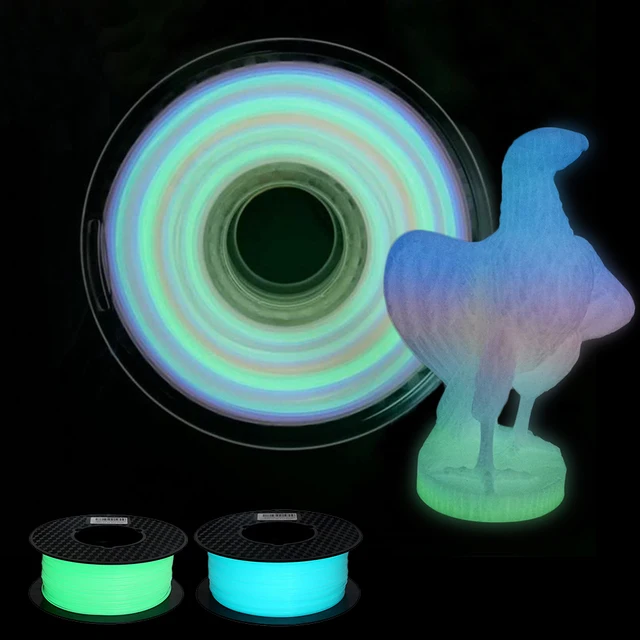 Certificates allow the use of this material for the production of implants. Also, this material, due to its quality characteristics, can be used in areas where the highest temperature resistance is required. For example, biomedical instruments and equipment.
Certificates allow the use of this material for the production of implants. Also, this material, due to its quality characteristics, can be used in areas where the highest temperature resistance is required. For example, biomedical instruments and equipment.
Cobalt-chromium properties for 3D printing
Powder alloy based on cobalt-chromium has increased heat resistance, the highest strength and wear resistance. This material is able to withstand the most difficult high loads and be used in the most severe conditions. The alloy is characterized by a fine uniform crystalline grain surface. Cobalt-chromium powder is also characterized by high corrosion resistance and acid resistance. In addition, the material has the following technical characteristics:
Yield strength Re 935 N/mm2
Tensile strength Rm 1030 N/mm2
Elongation at break A 10 %
Young's modulus 230 kN/mm2
Melting point ∆ 1320 - 14200C
Thermal density coefficient ρ 8.6 g/cm3
expansion TEC (25-5000C) 14.